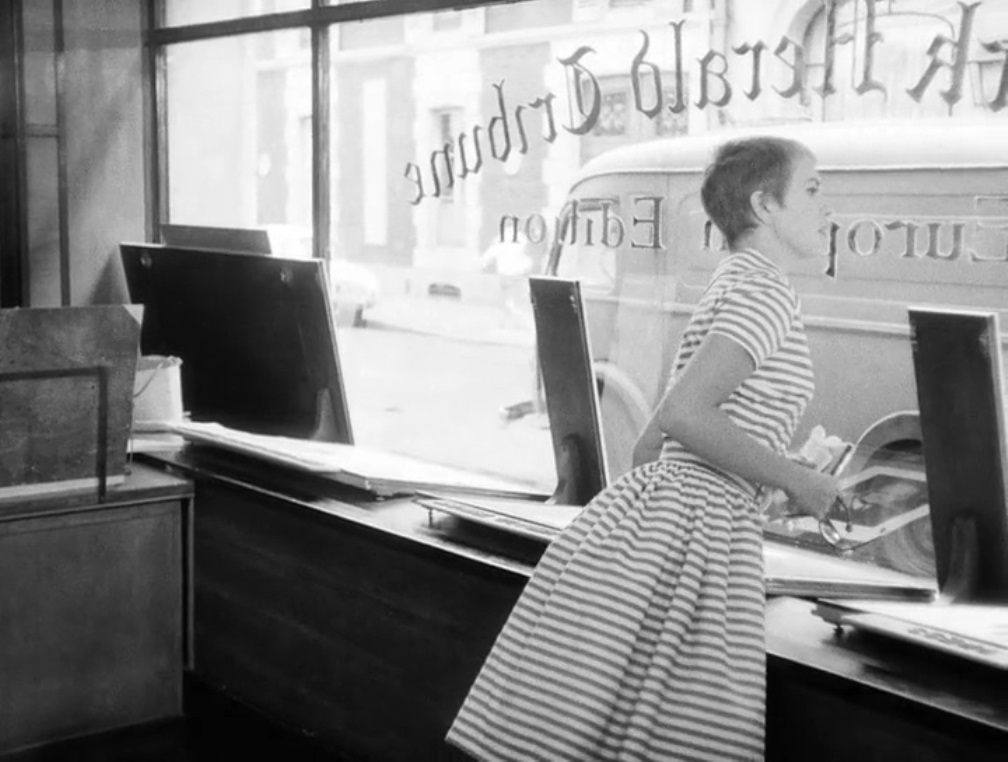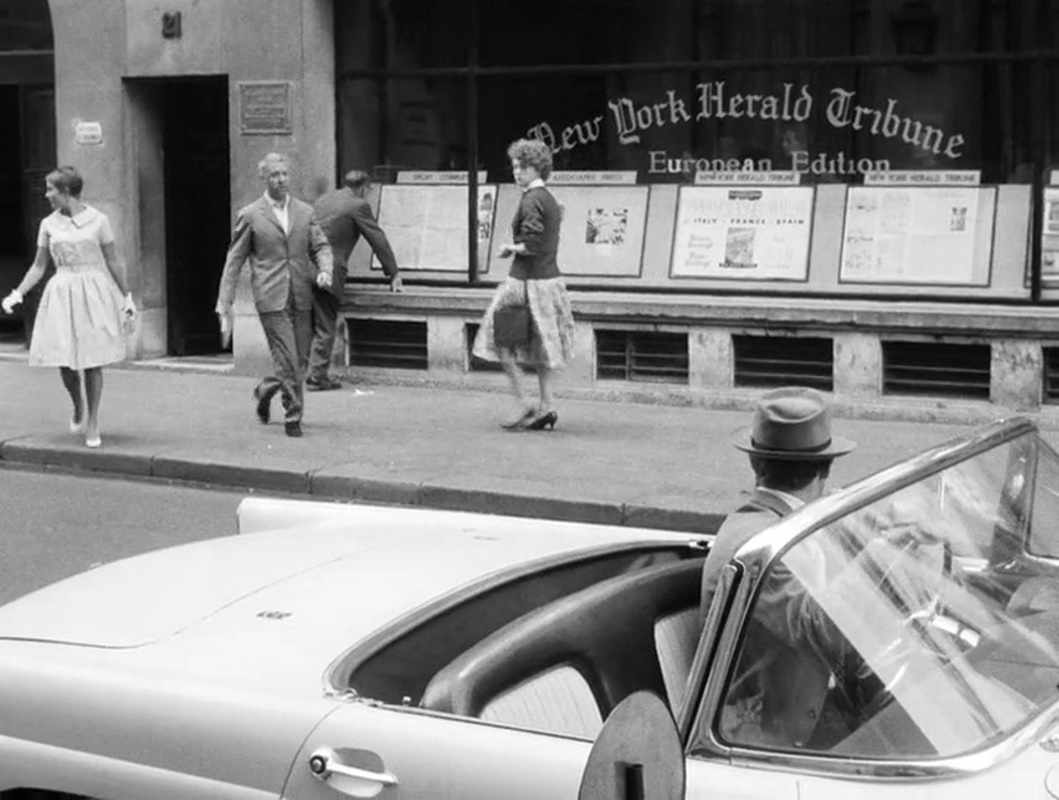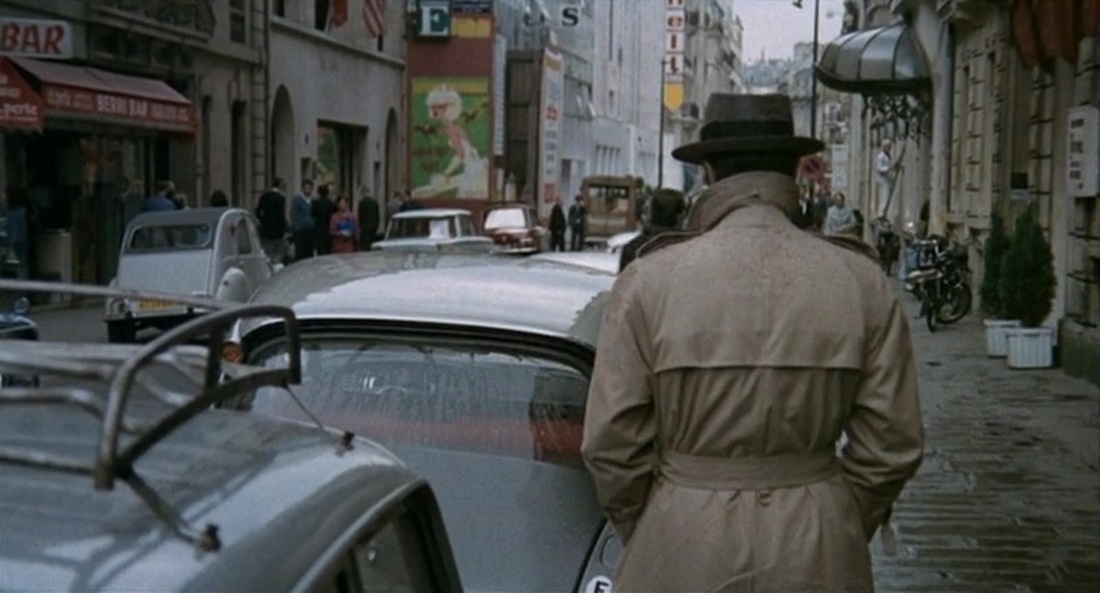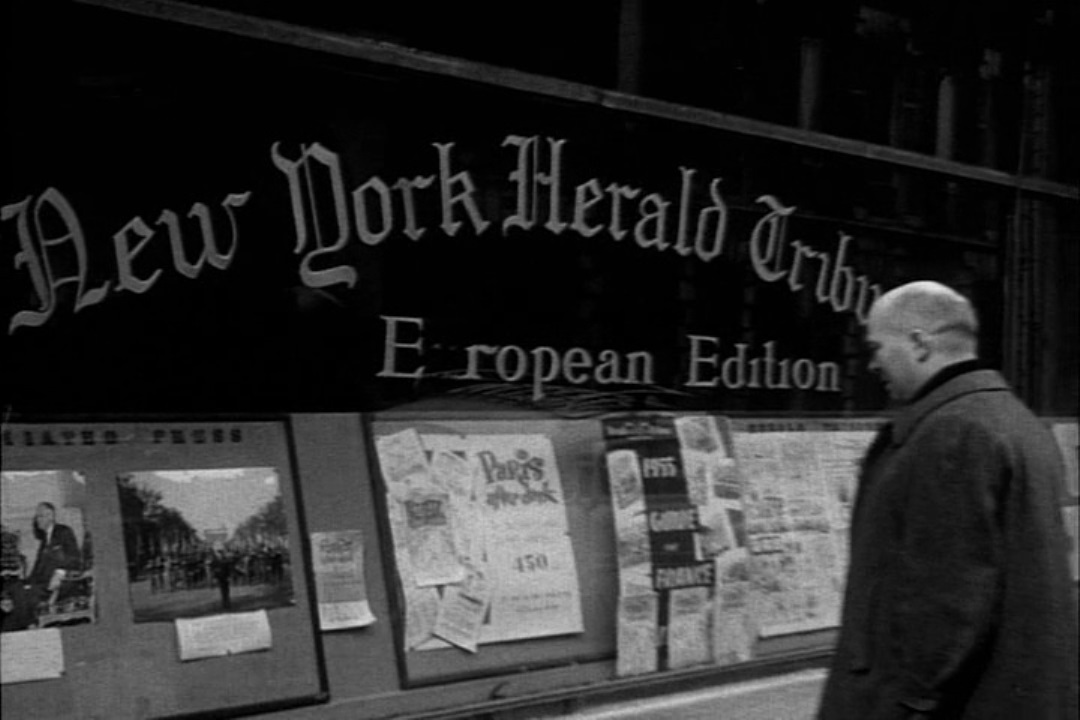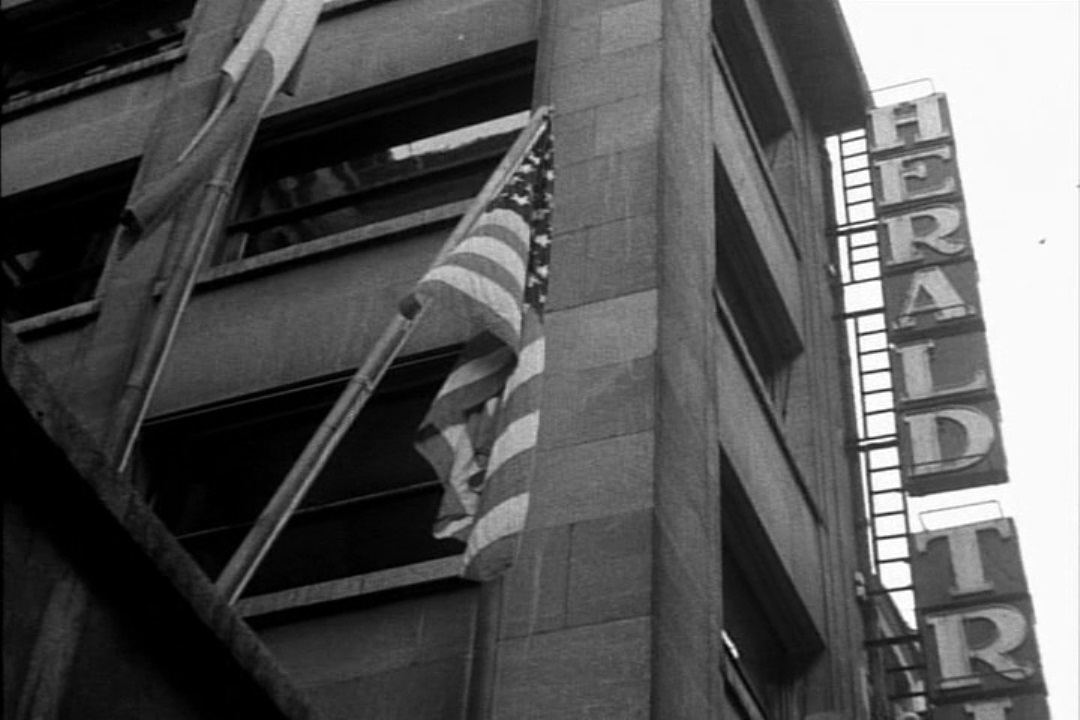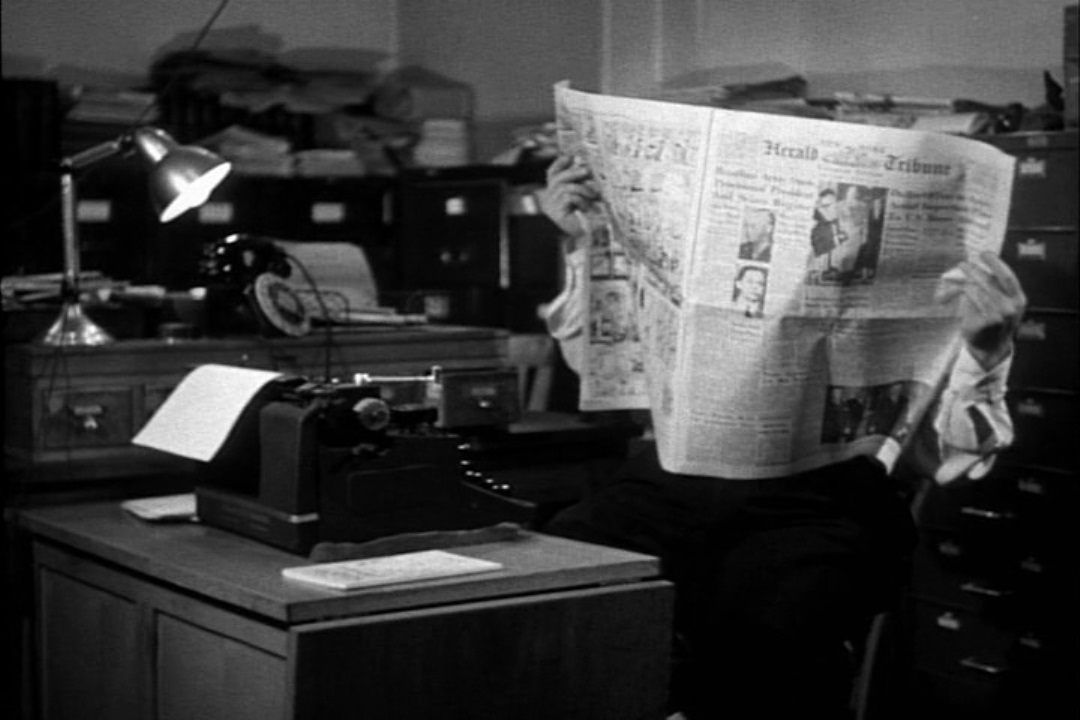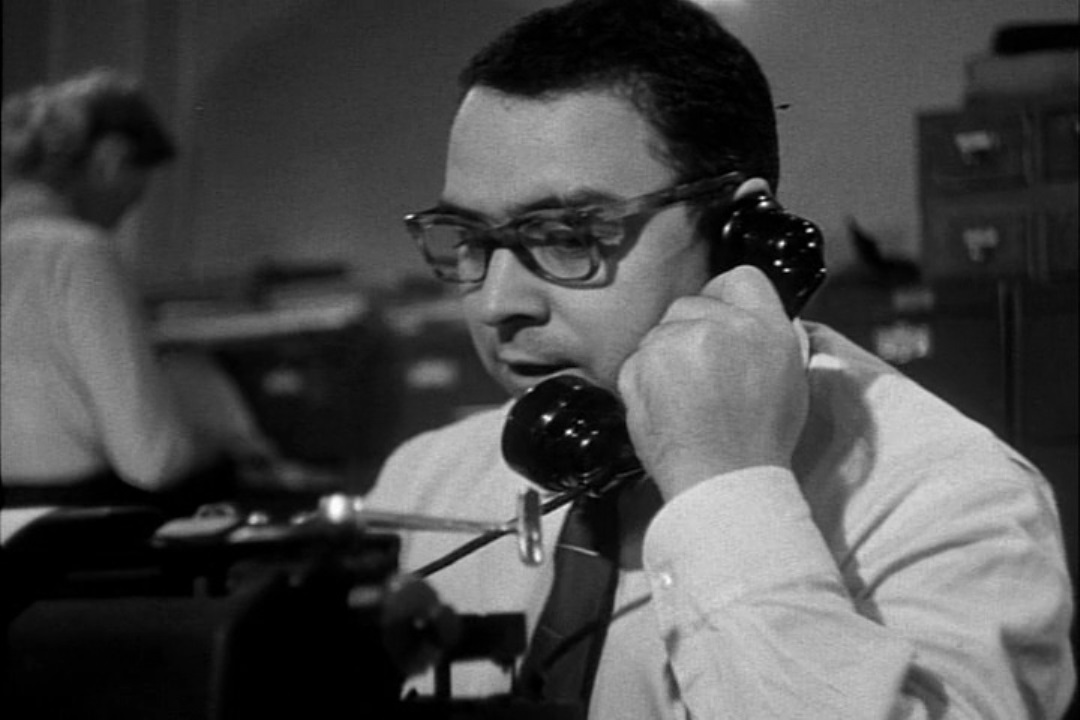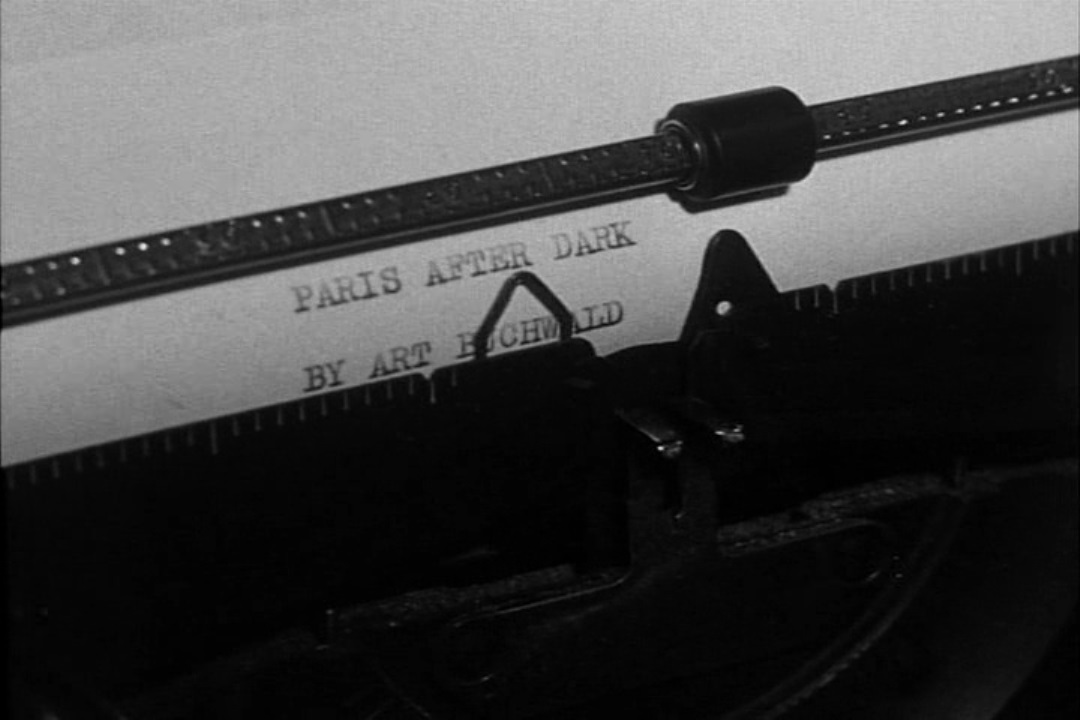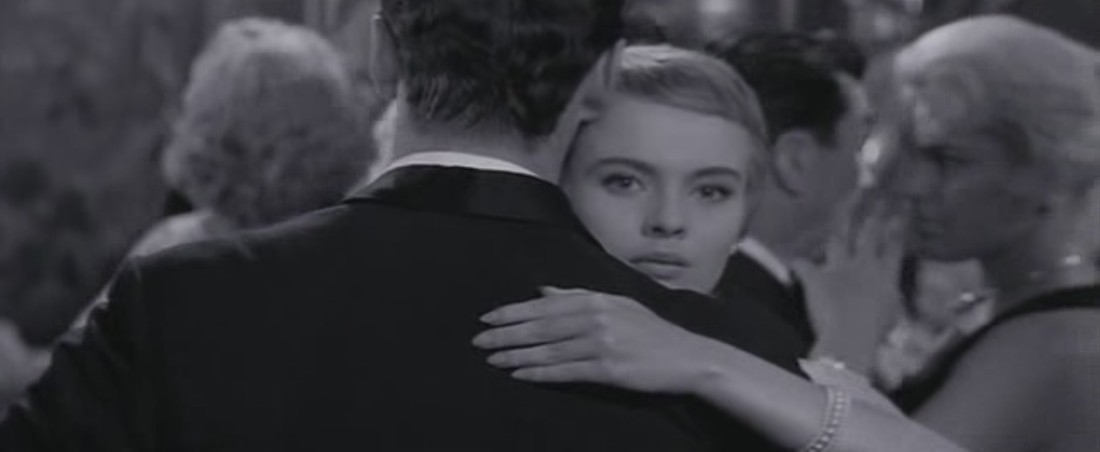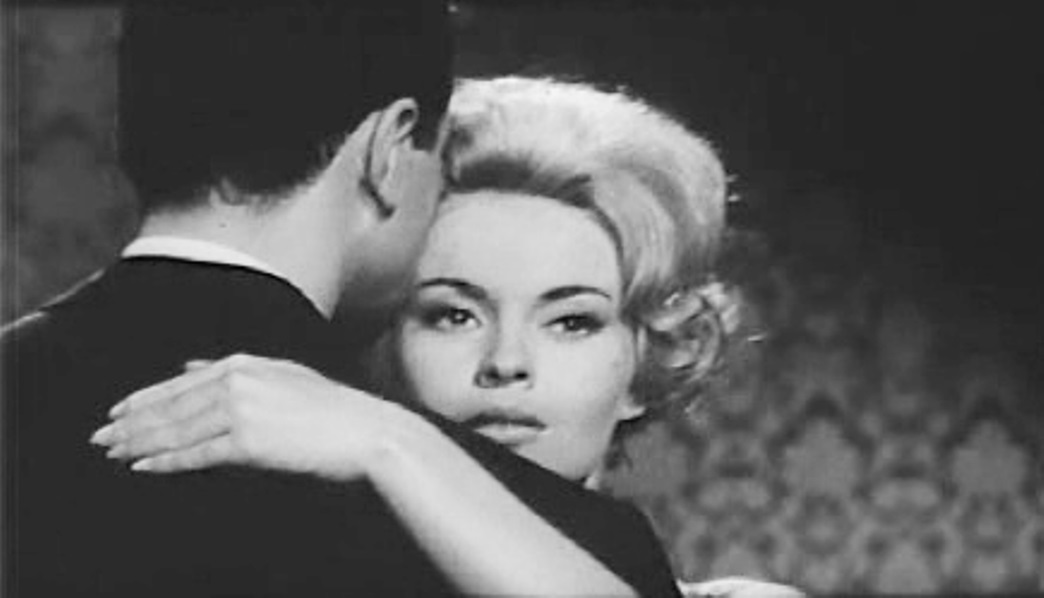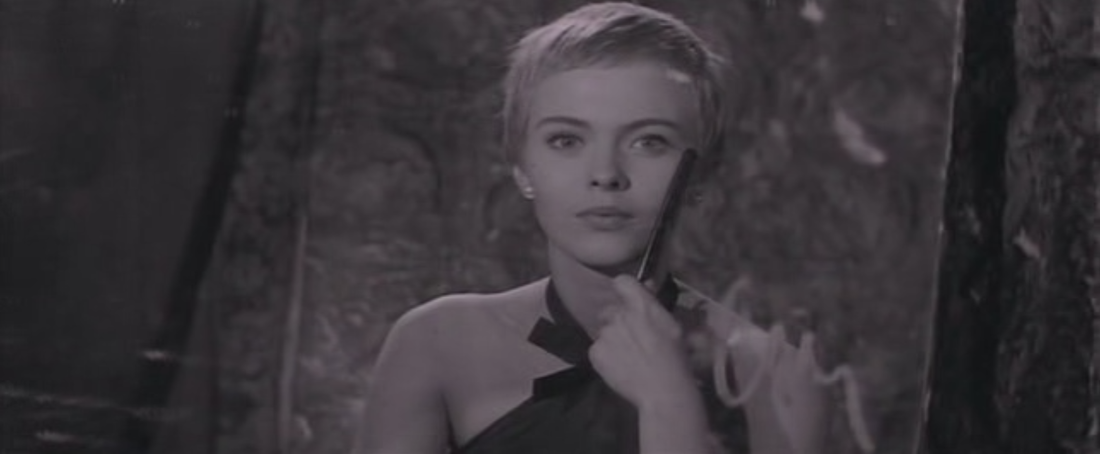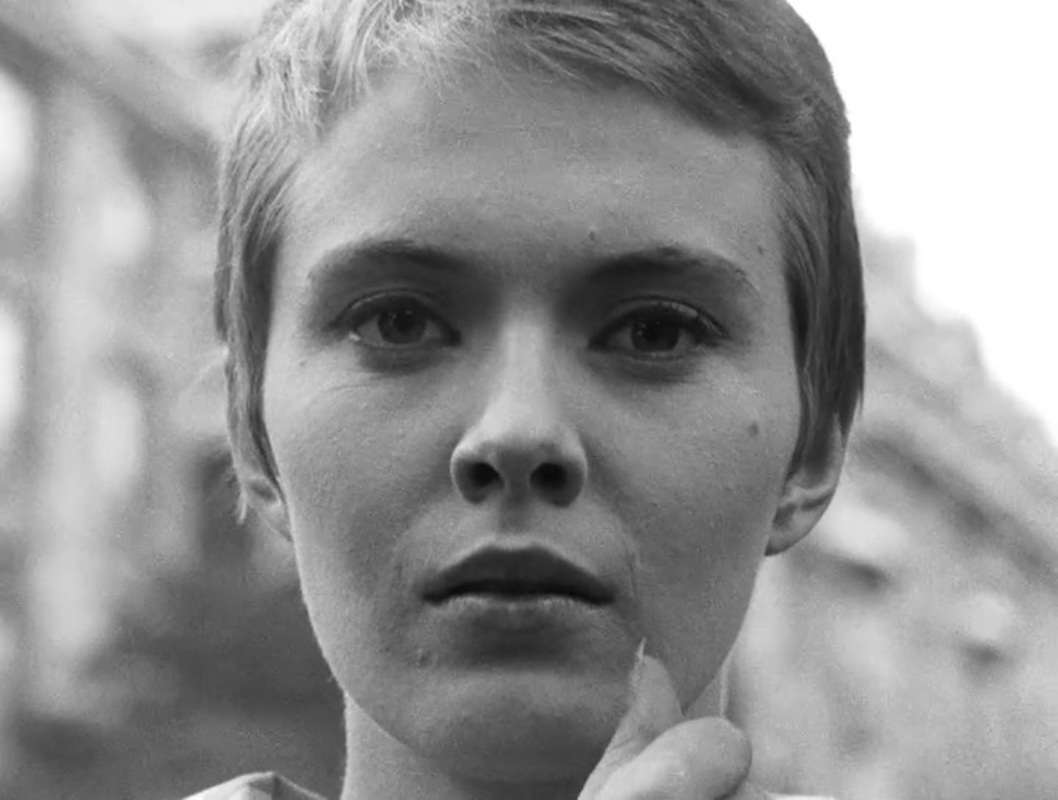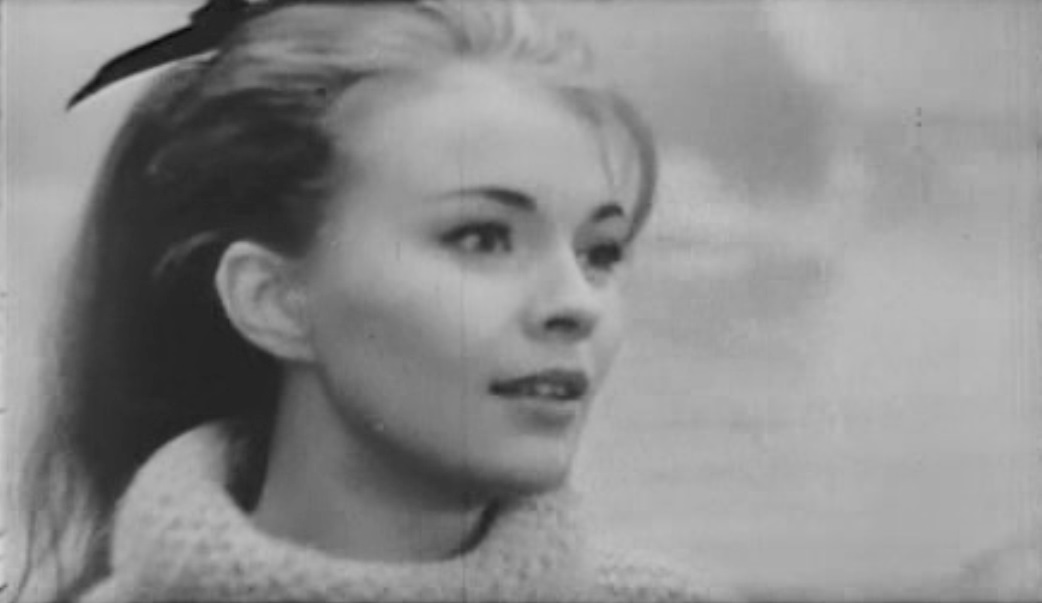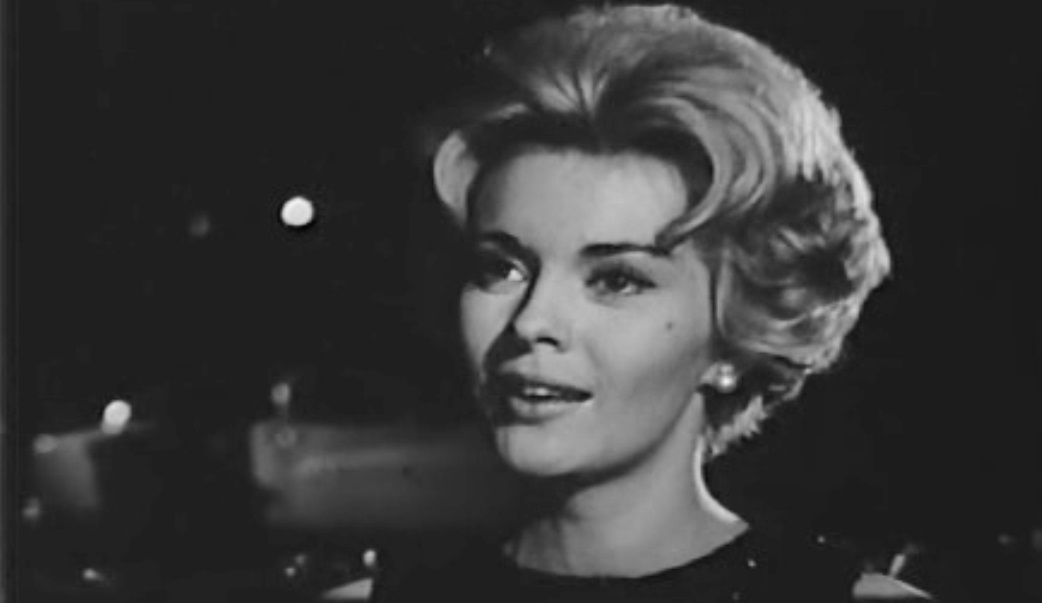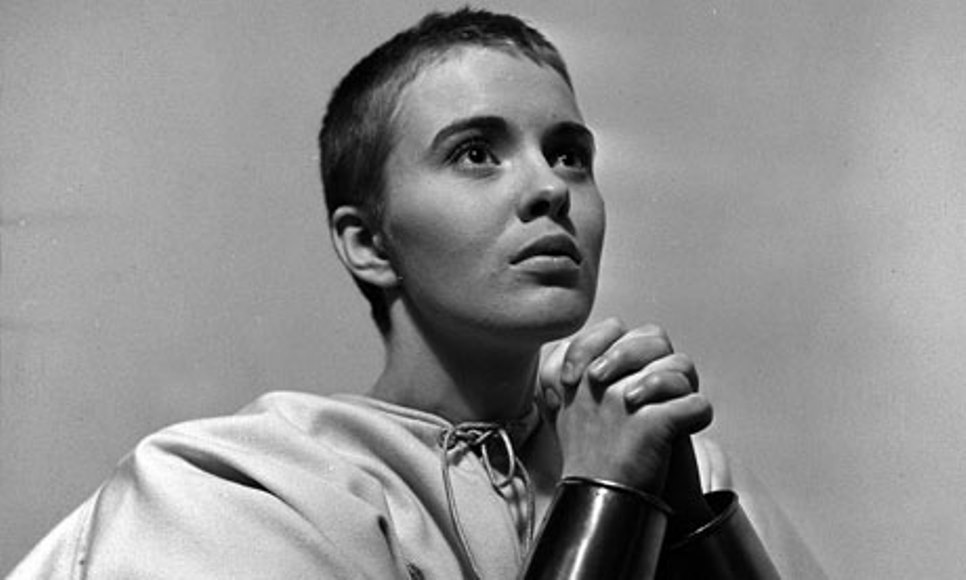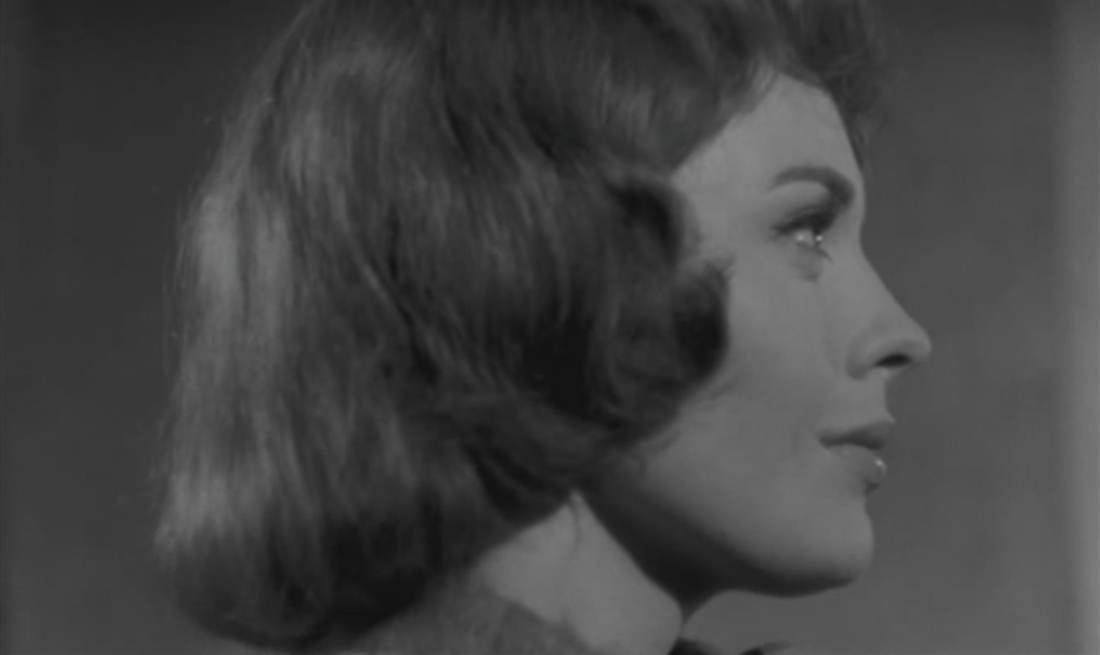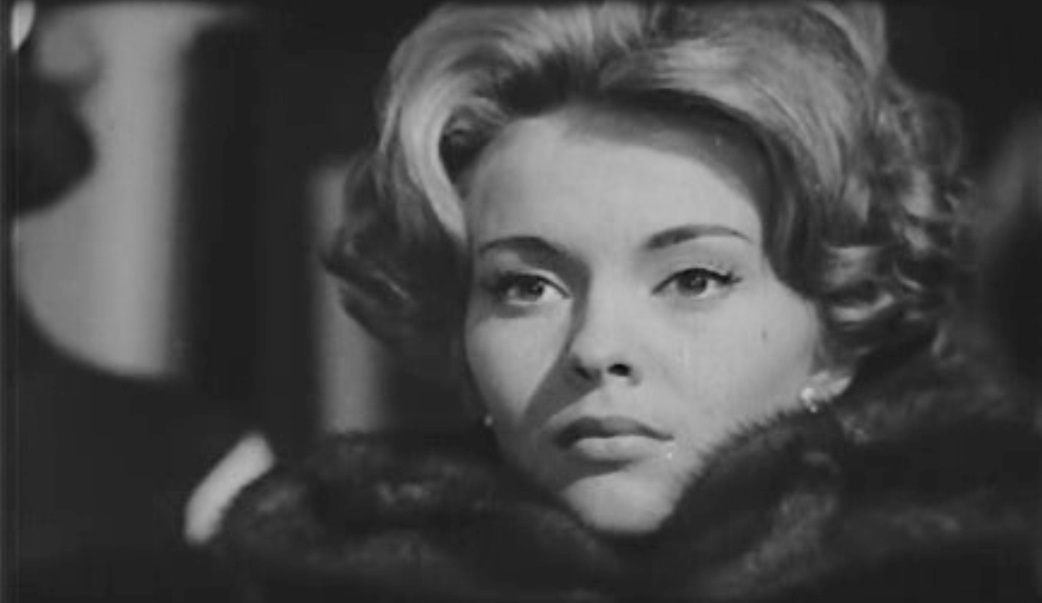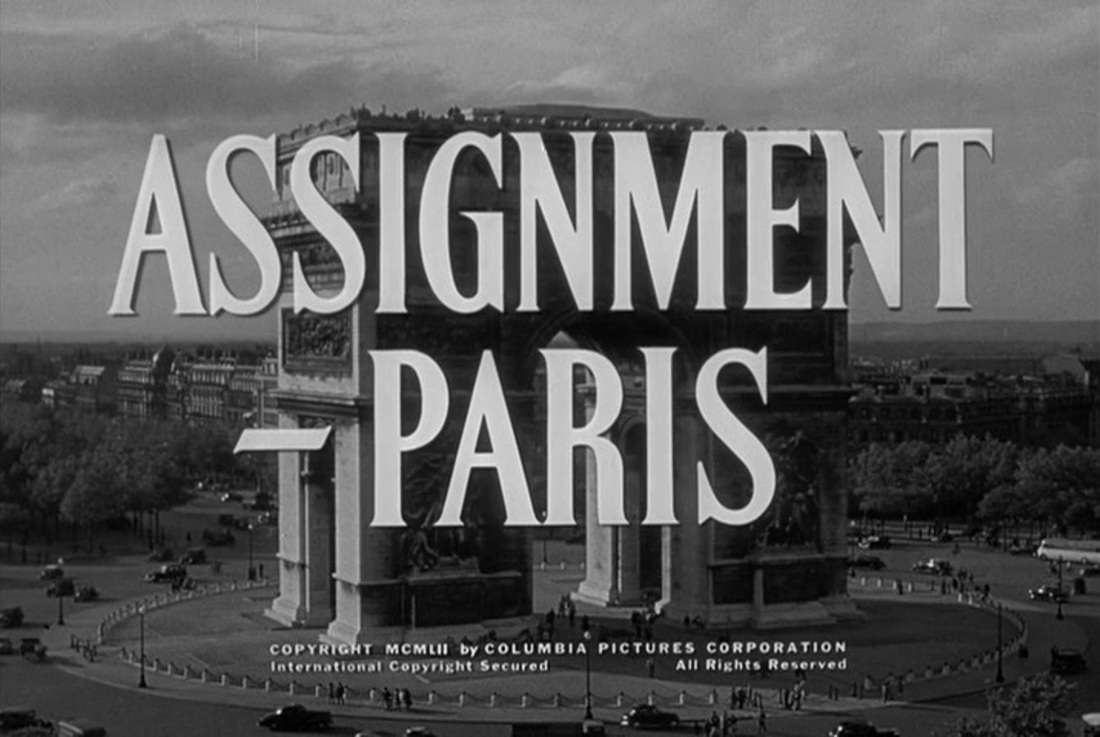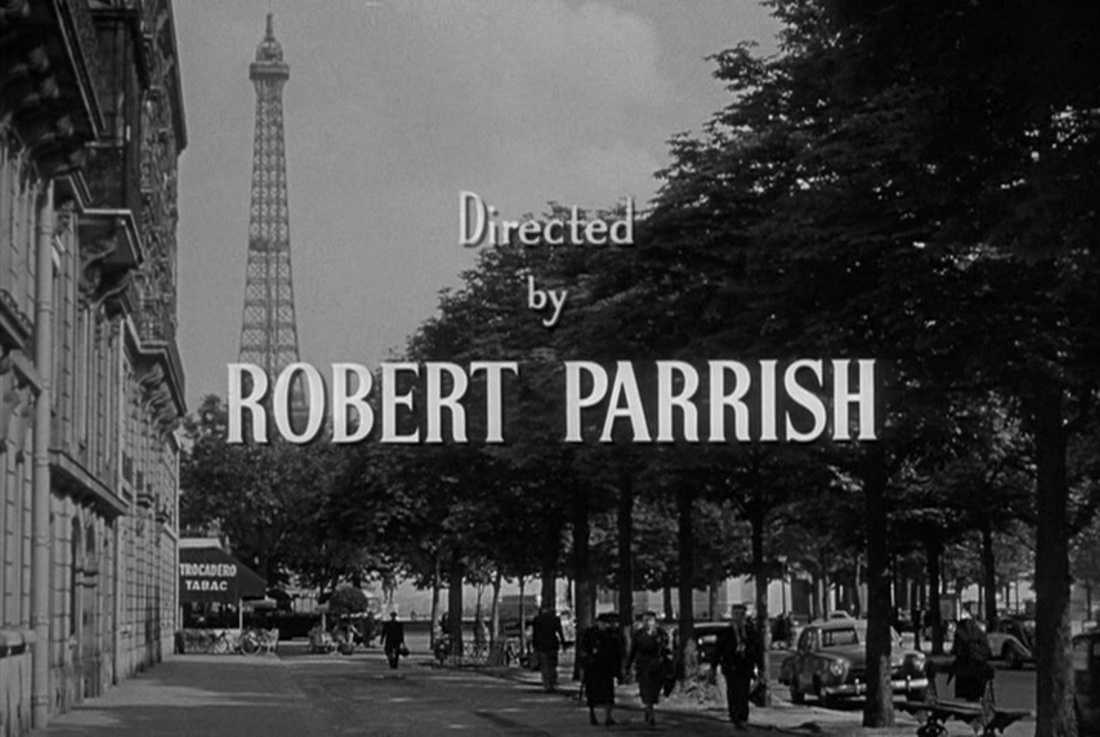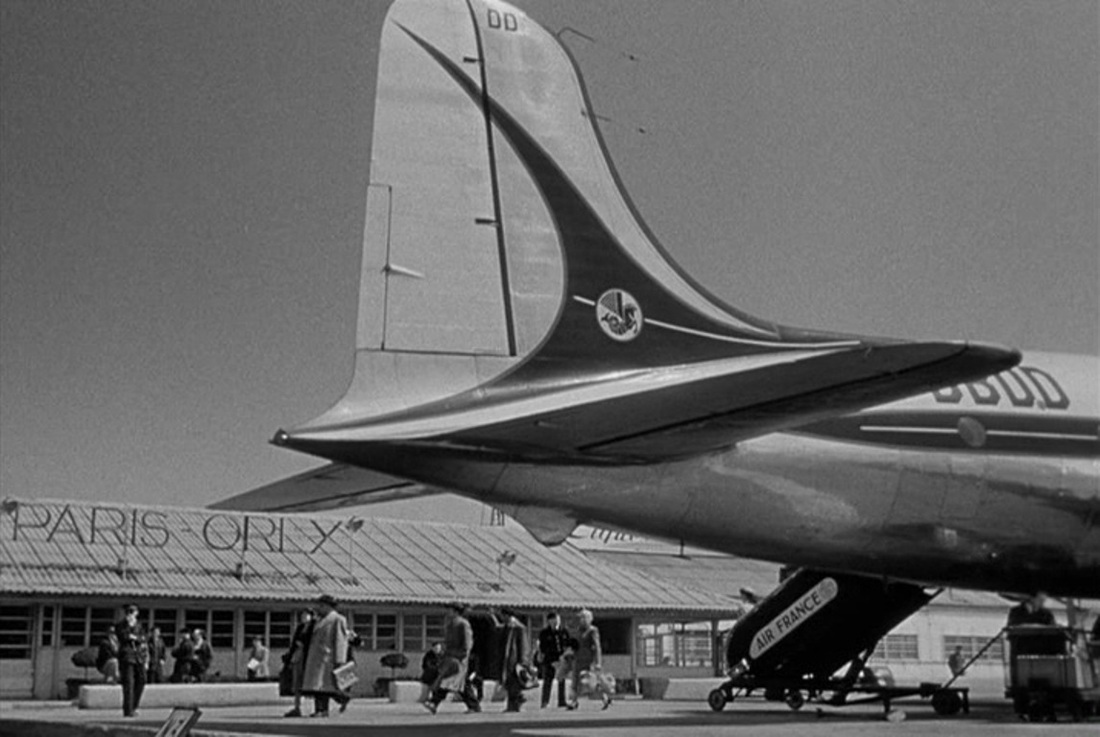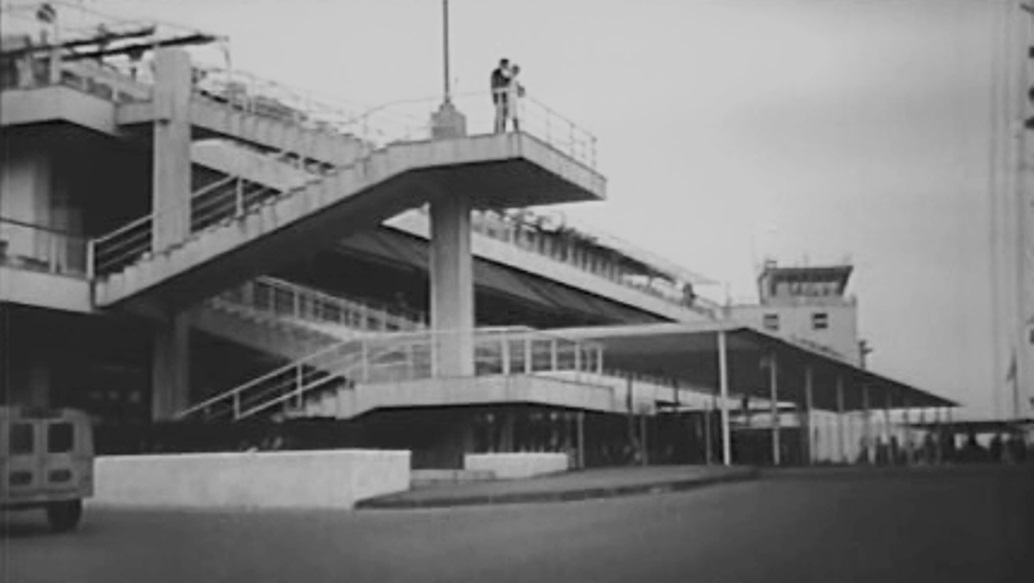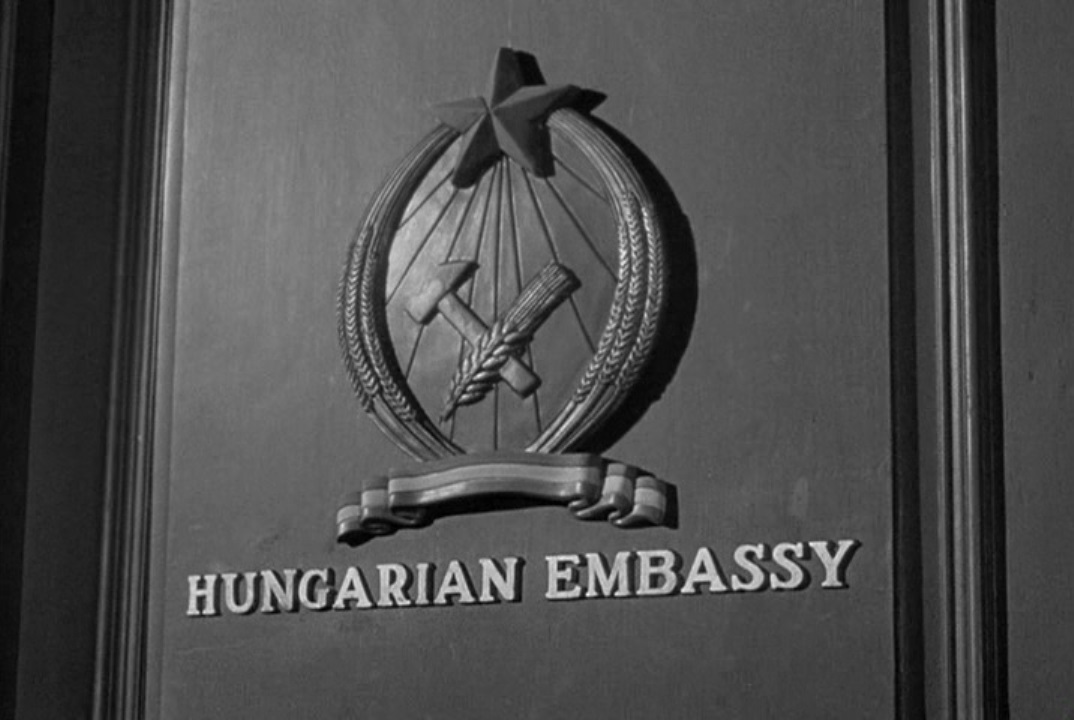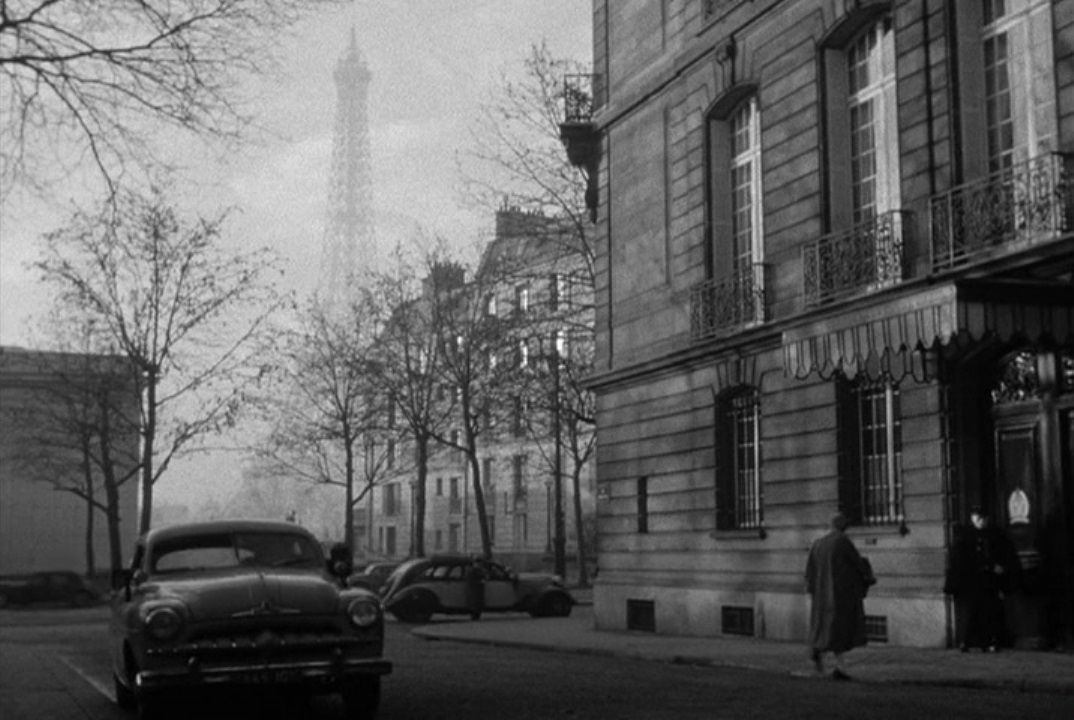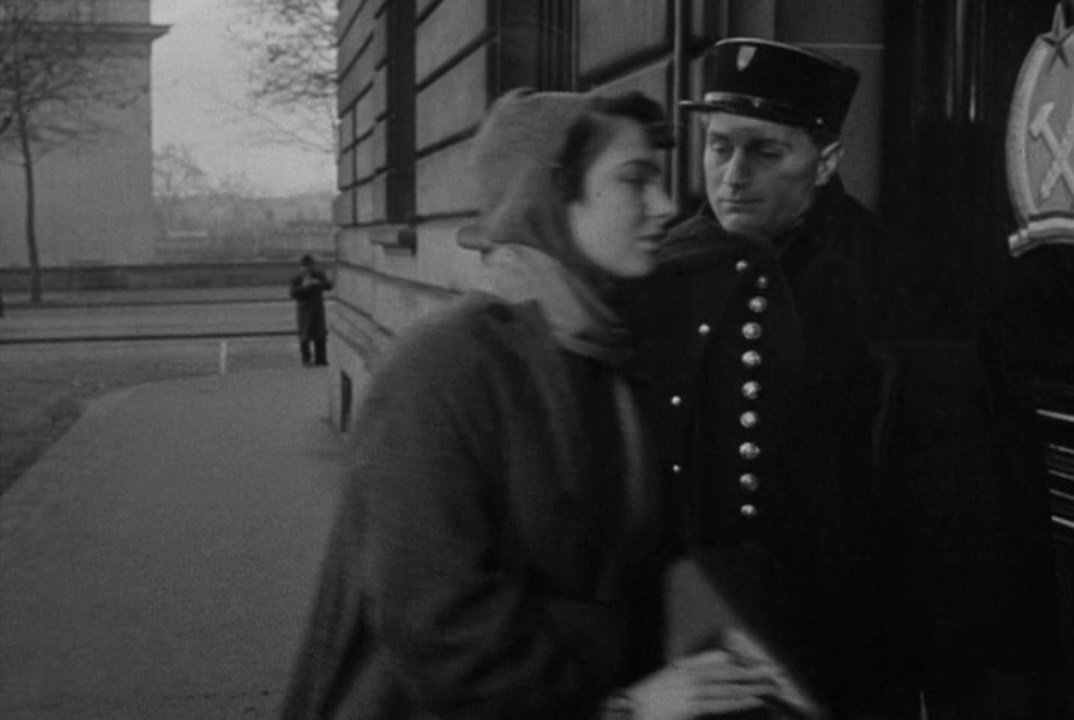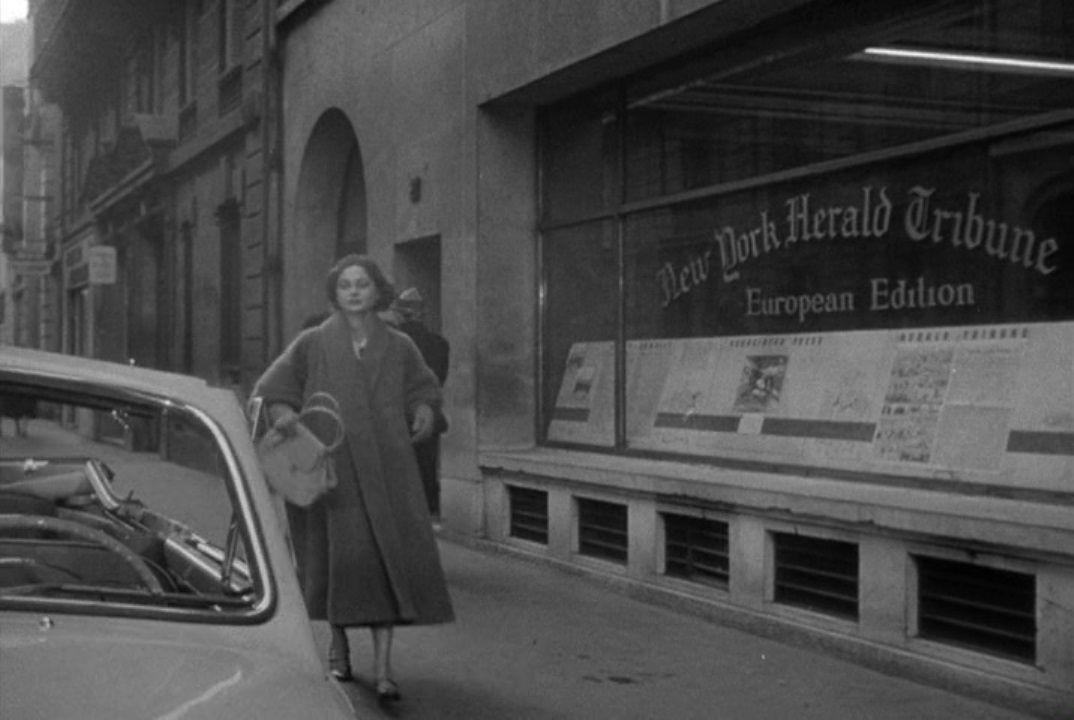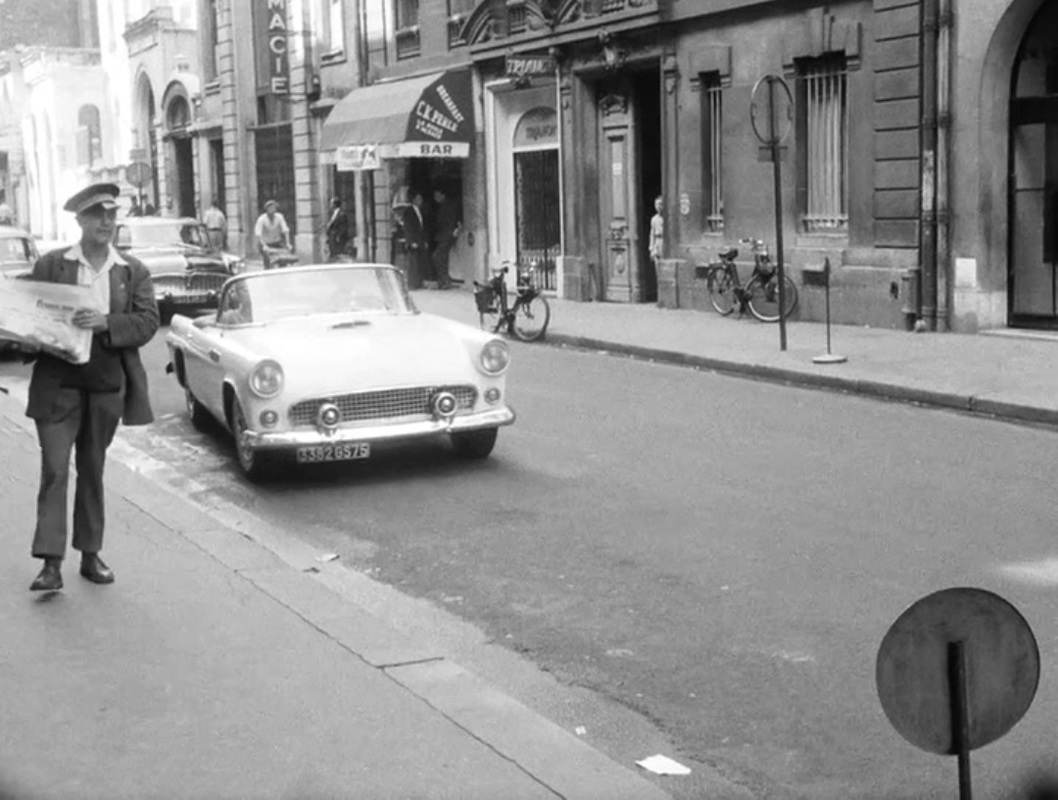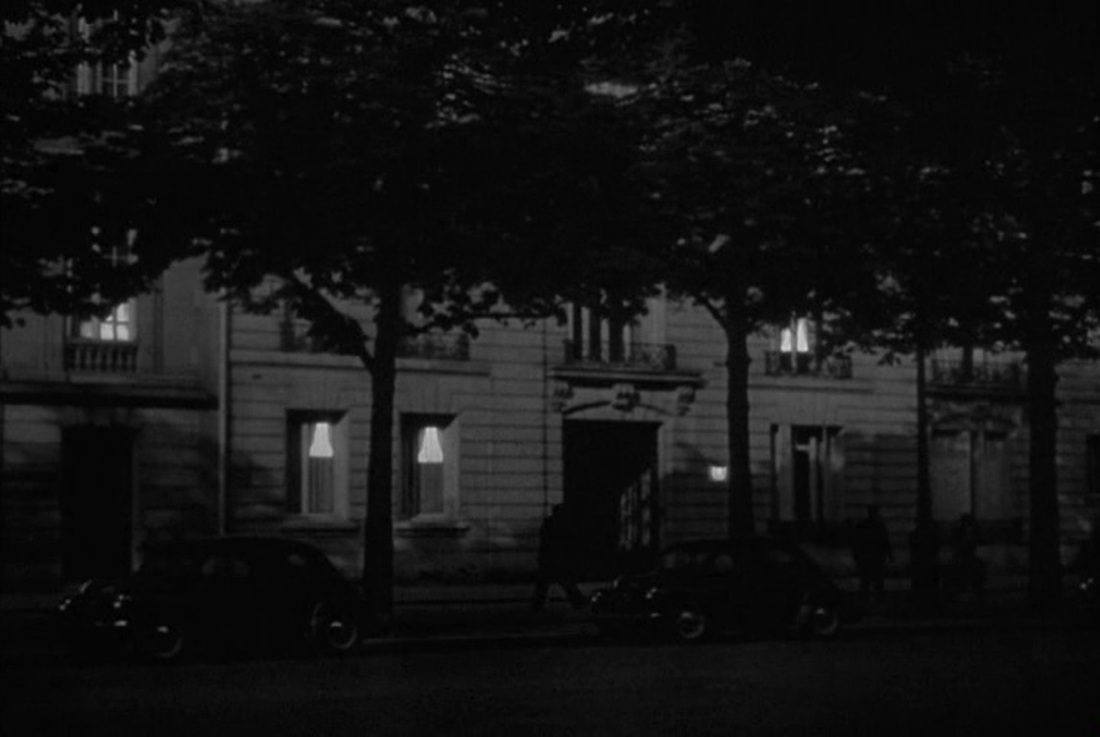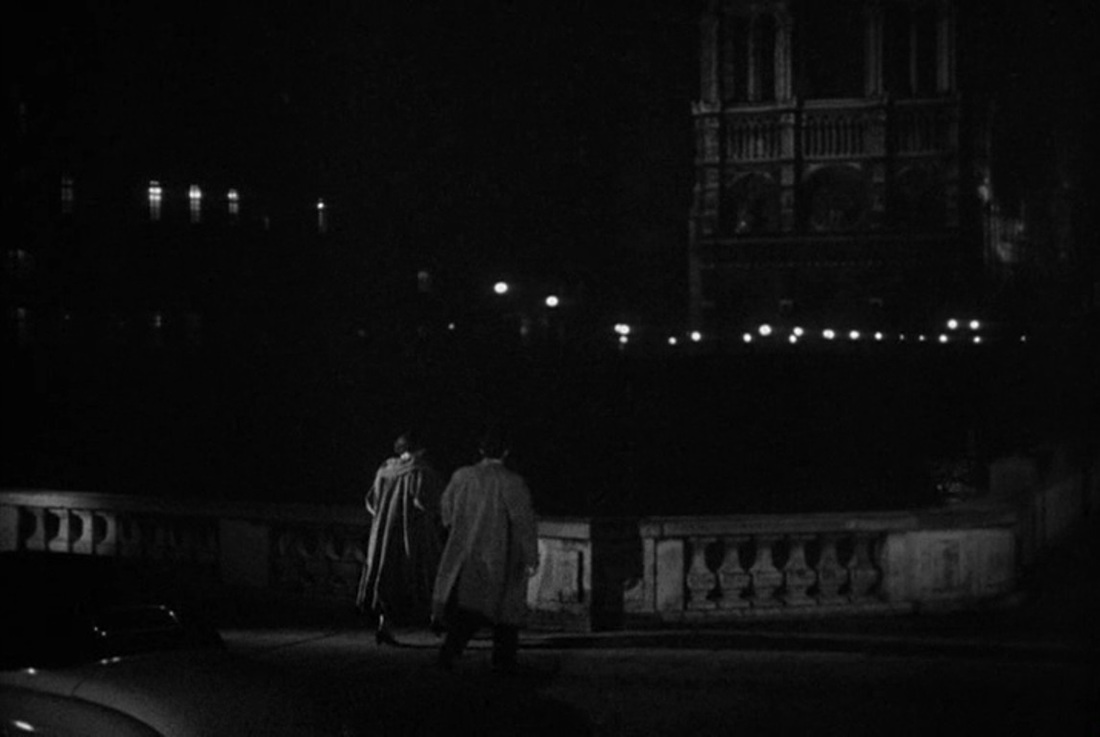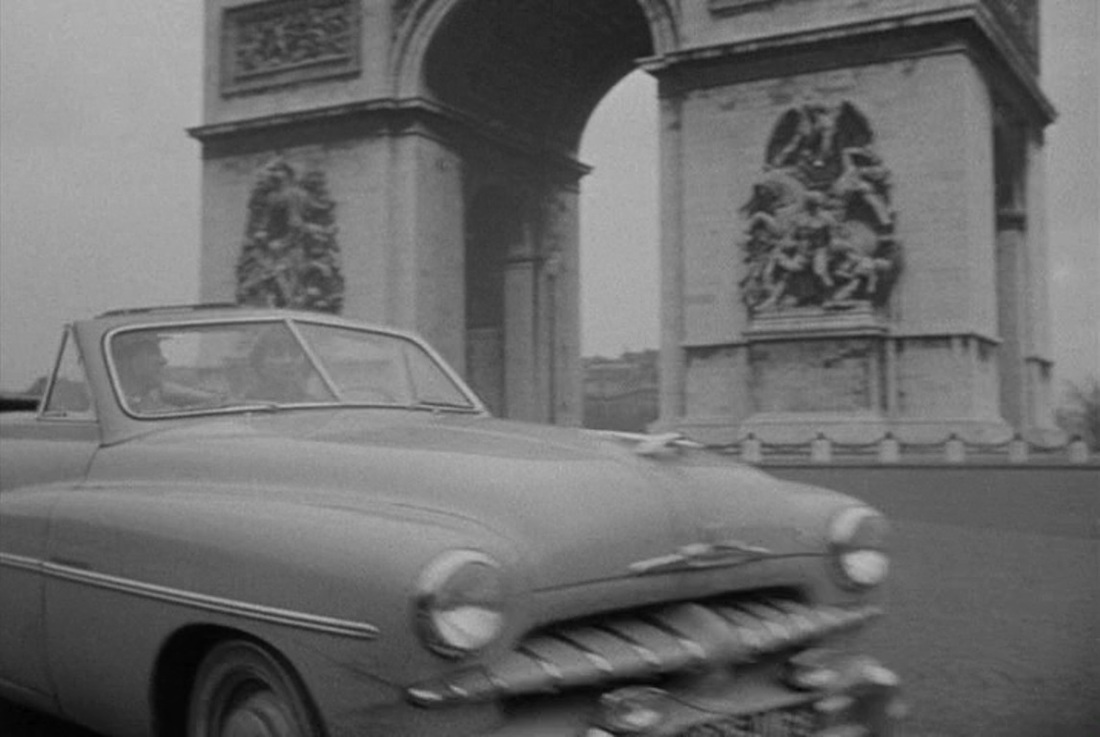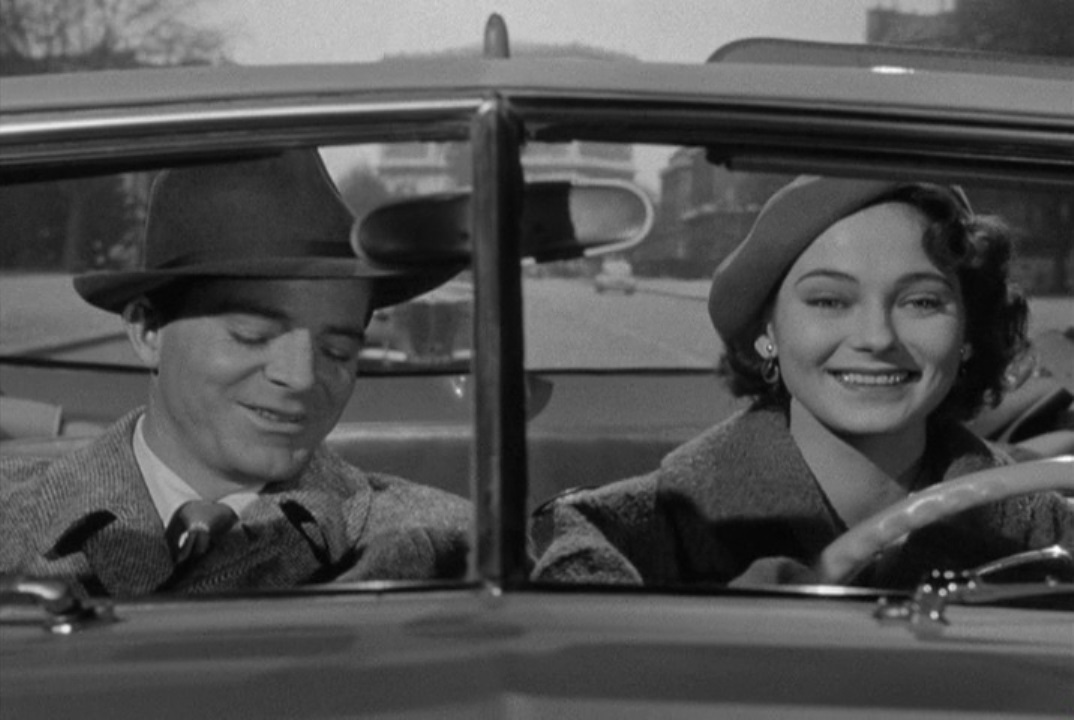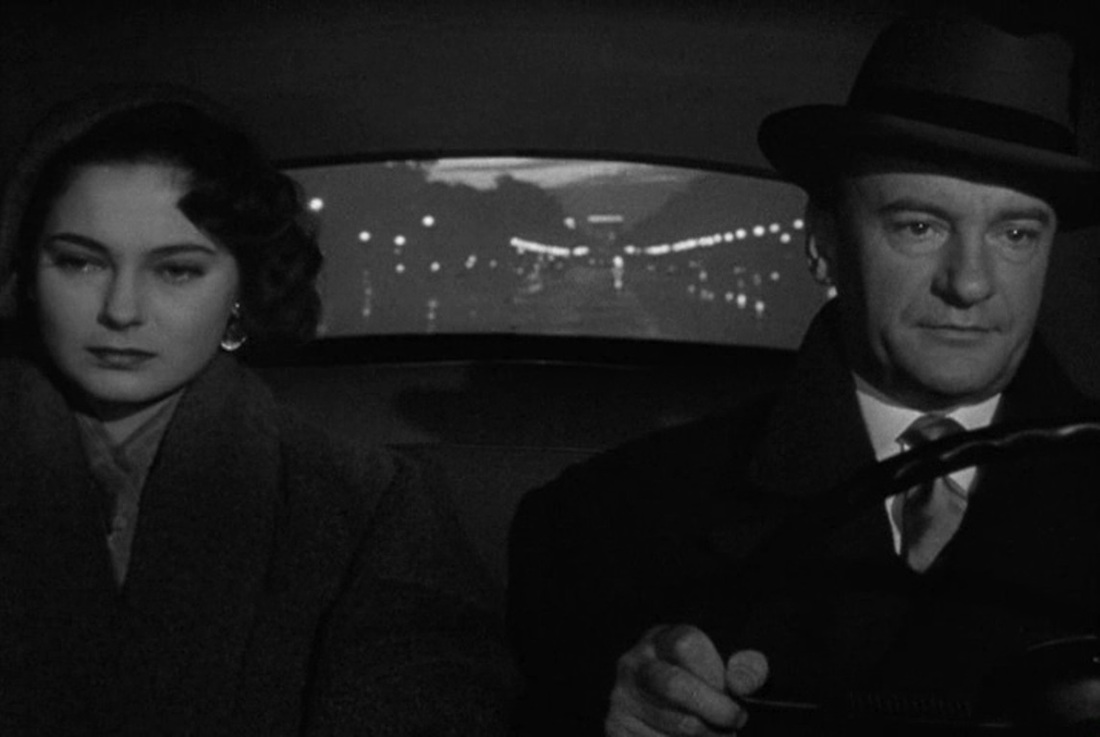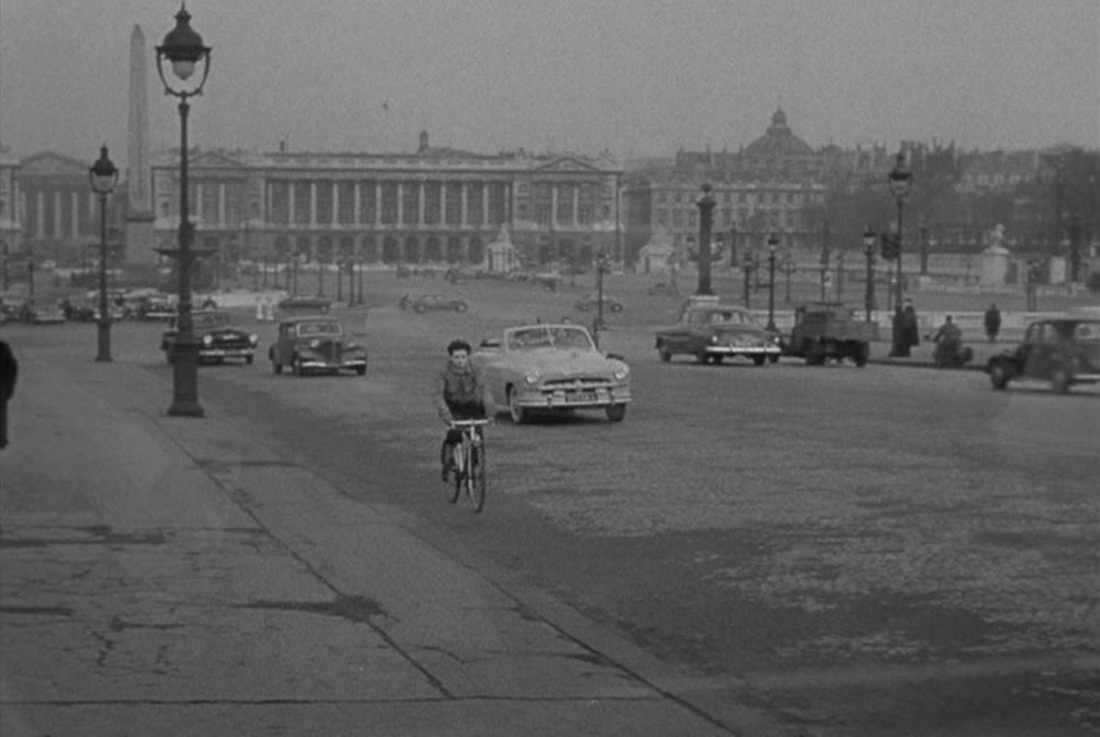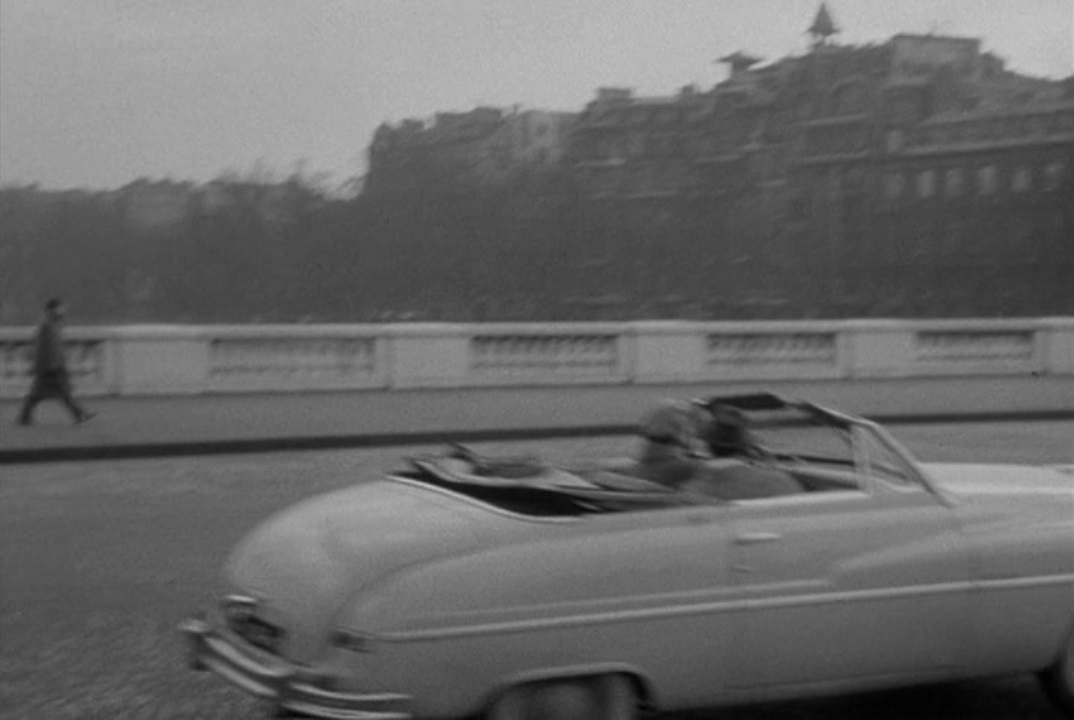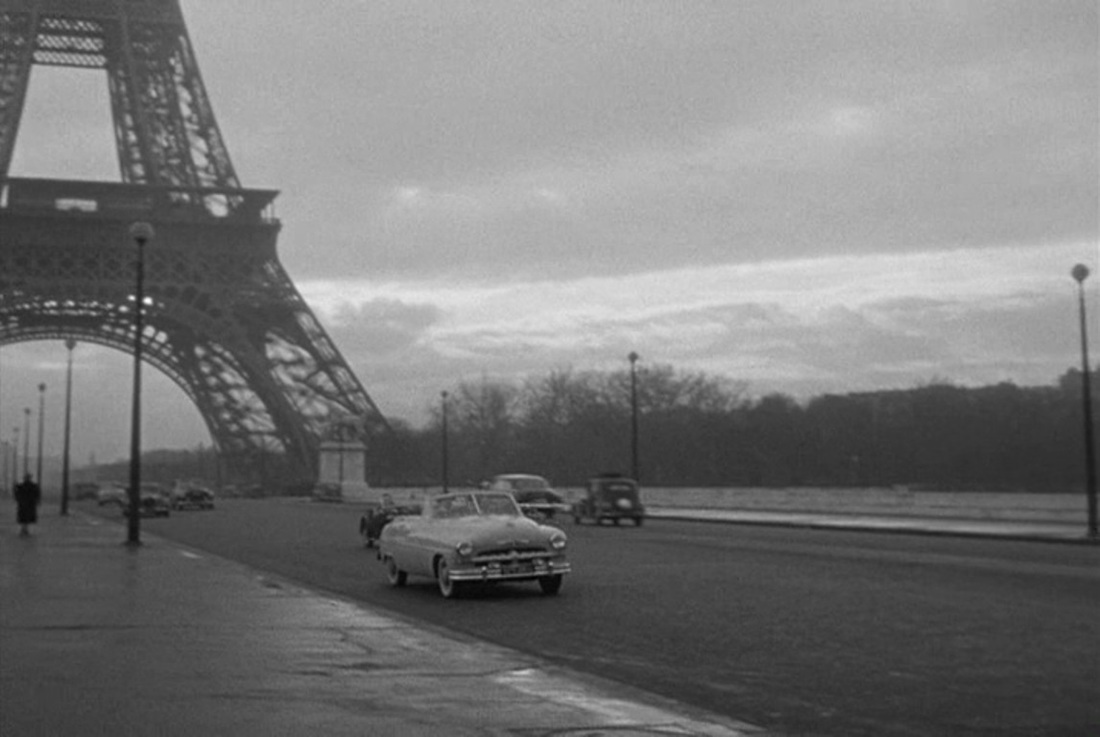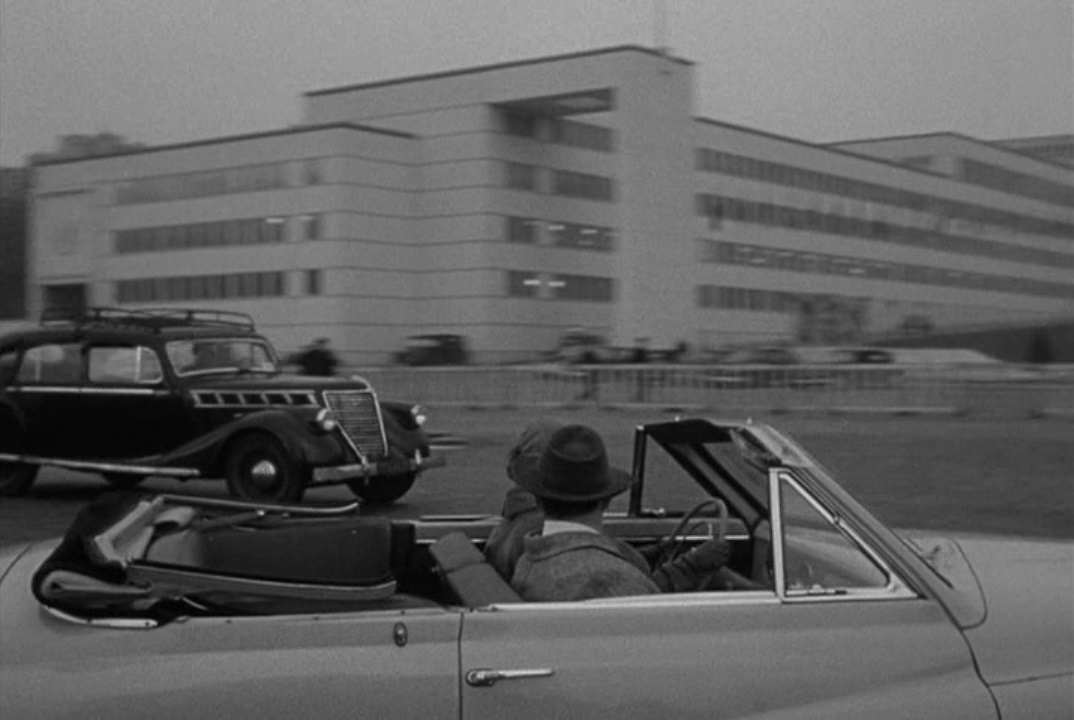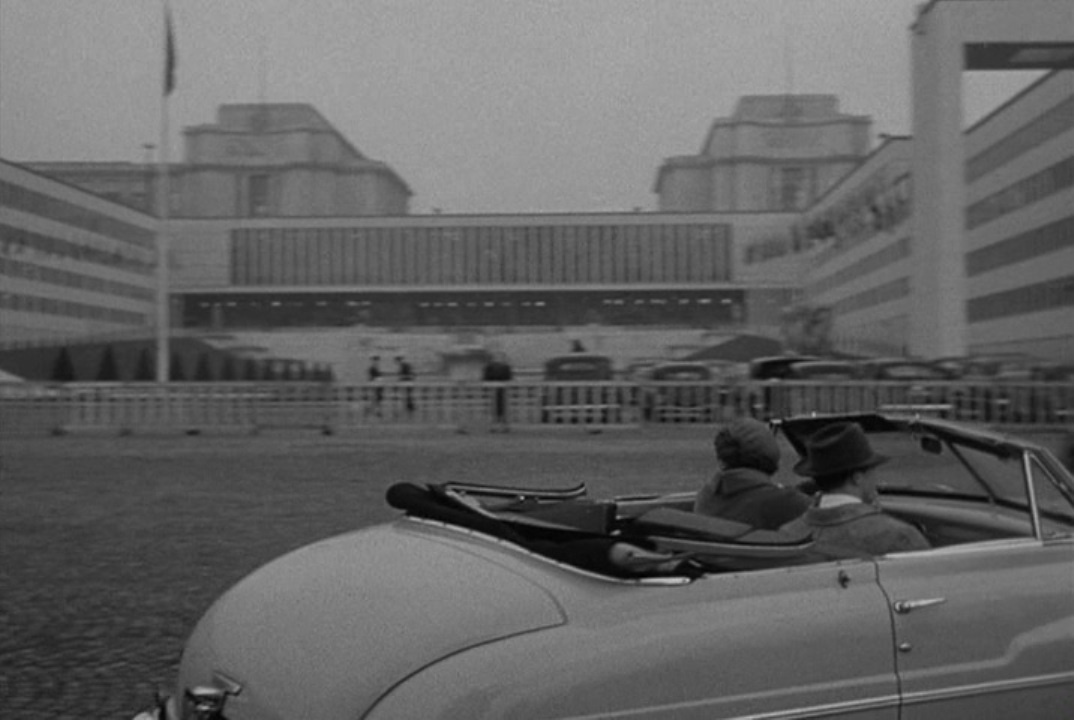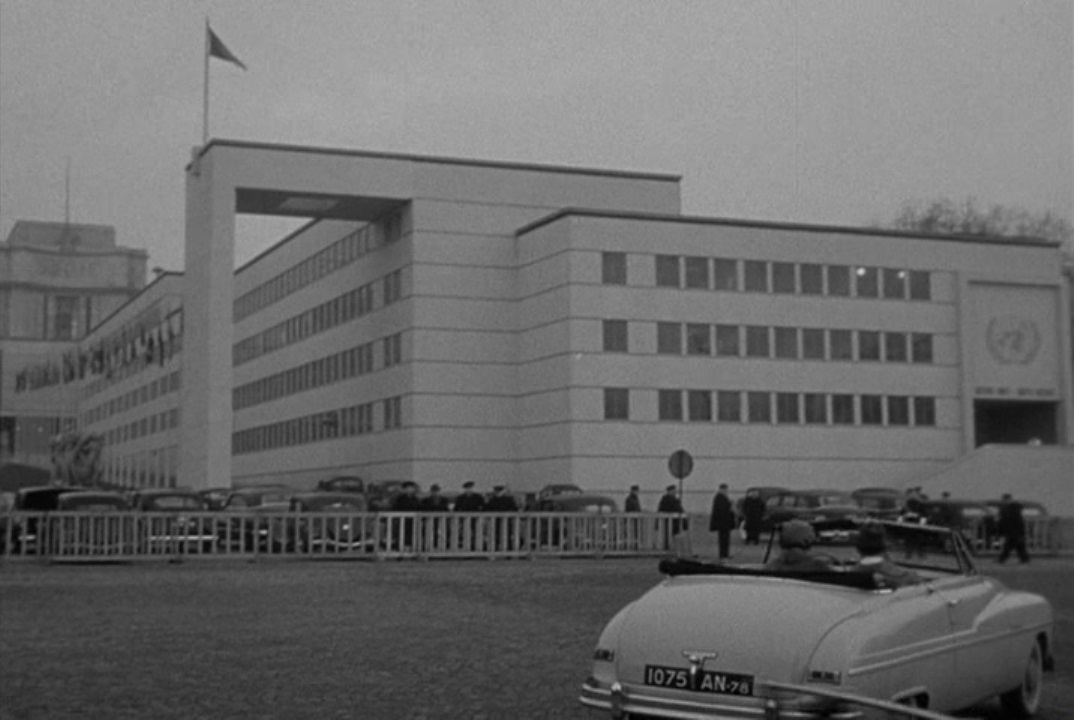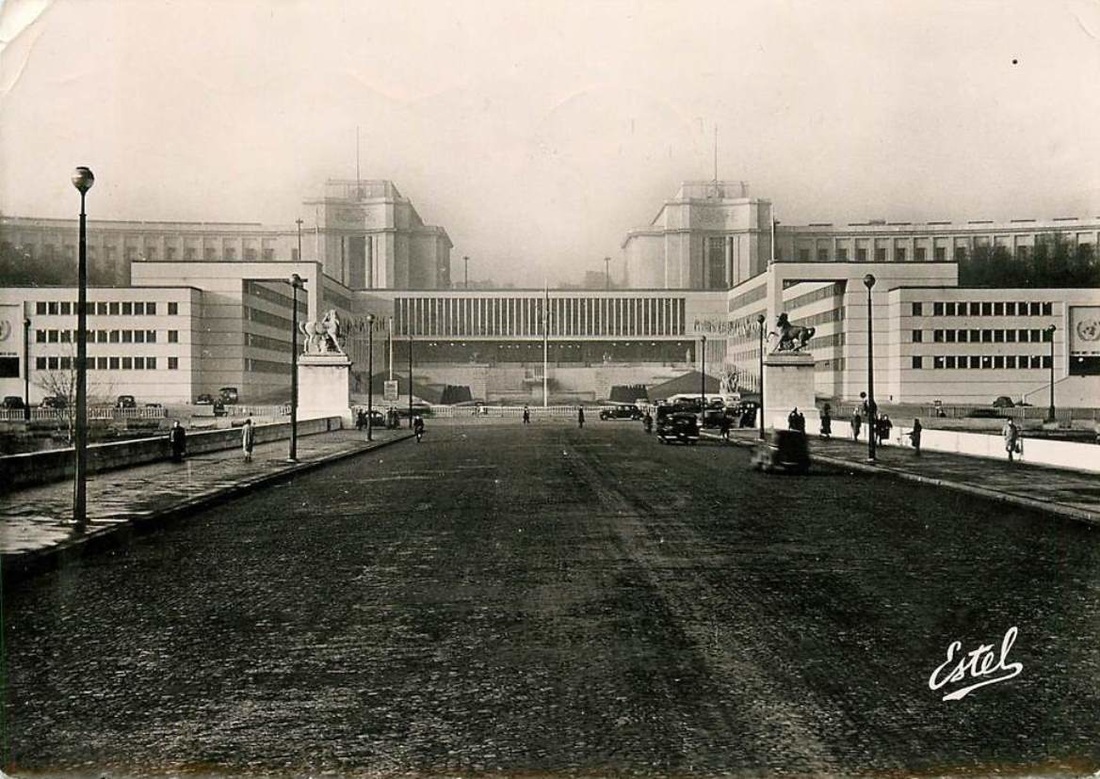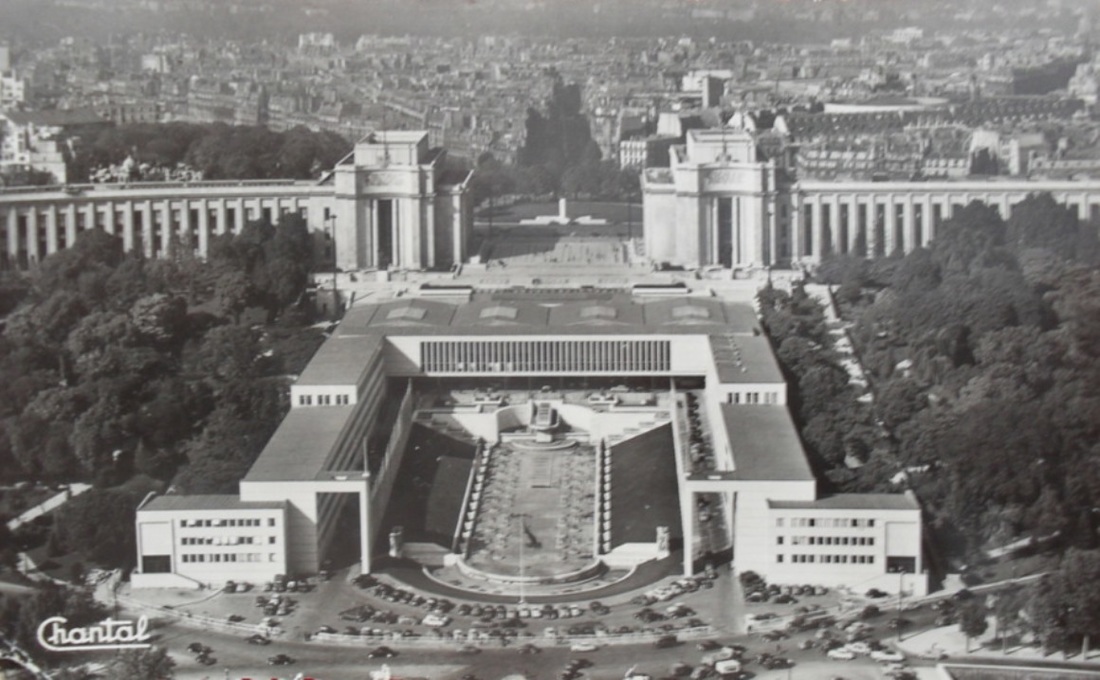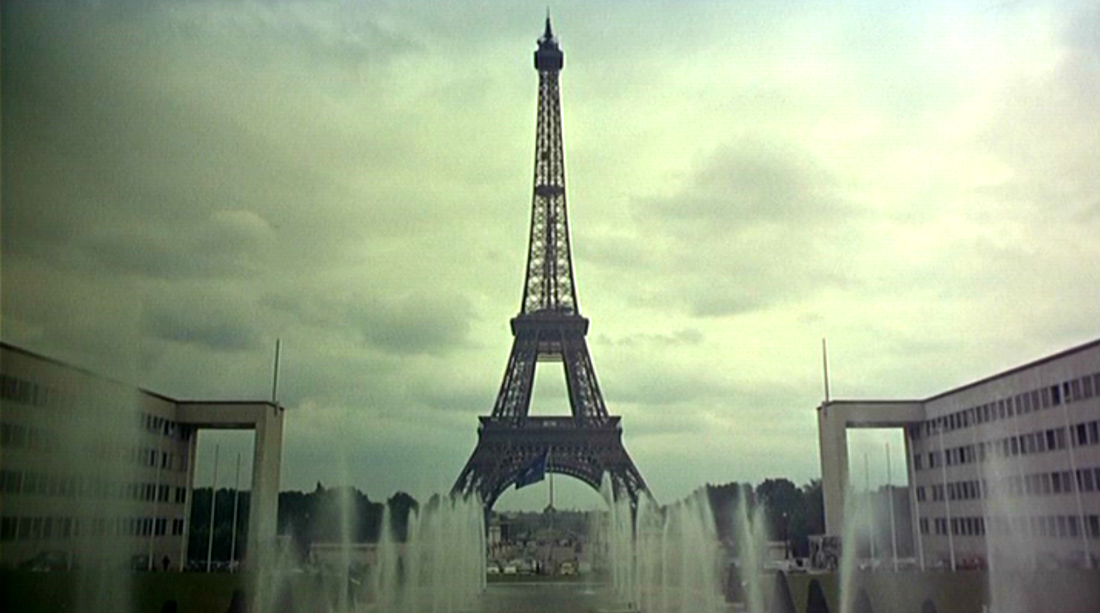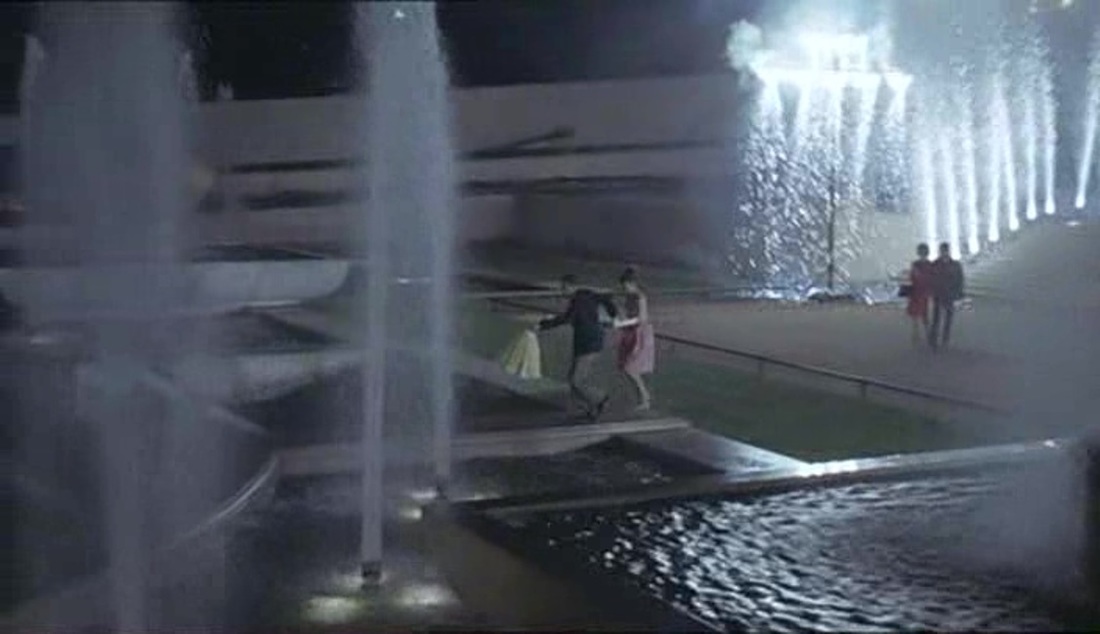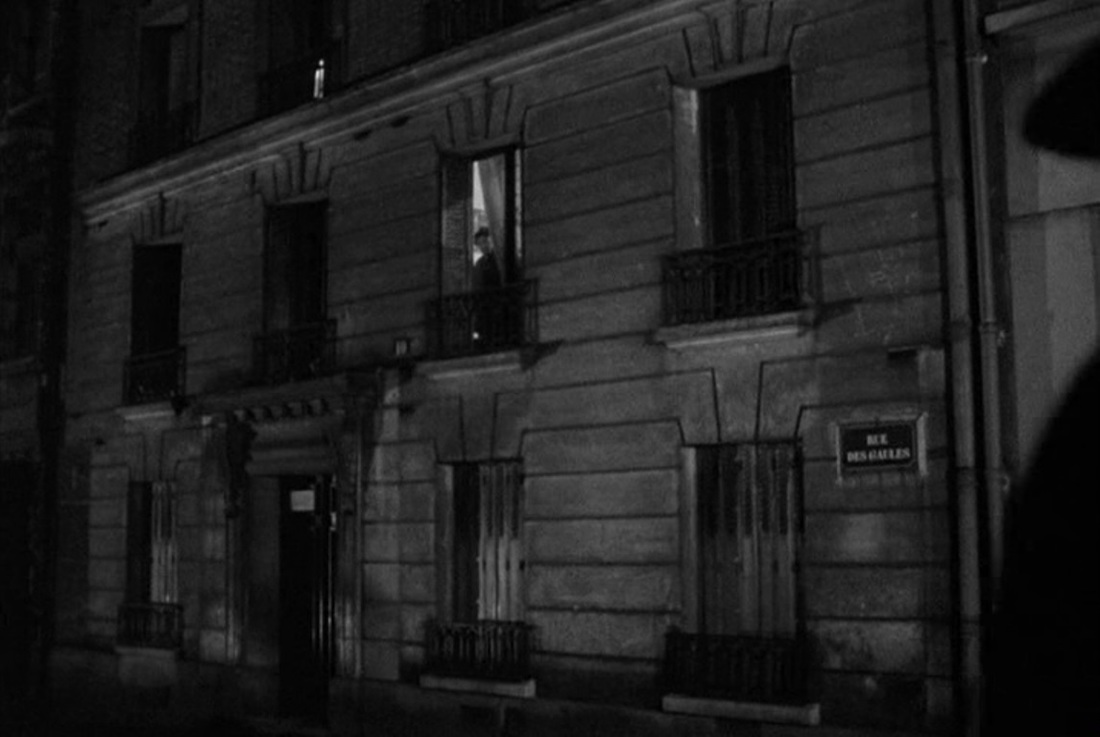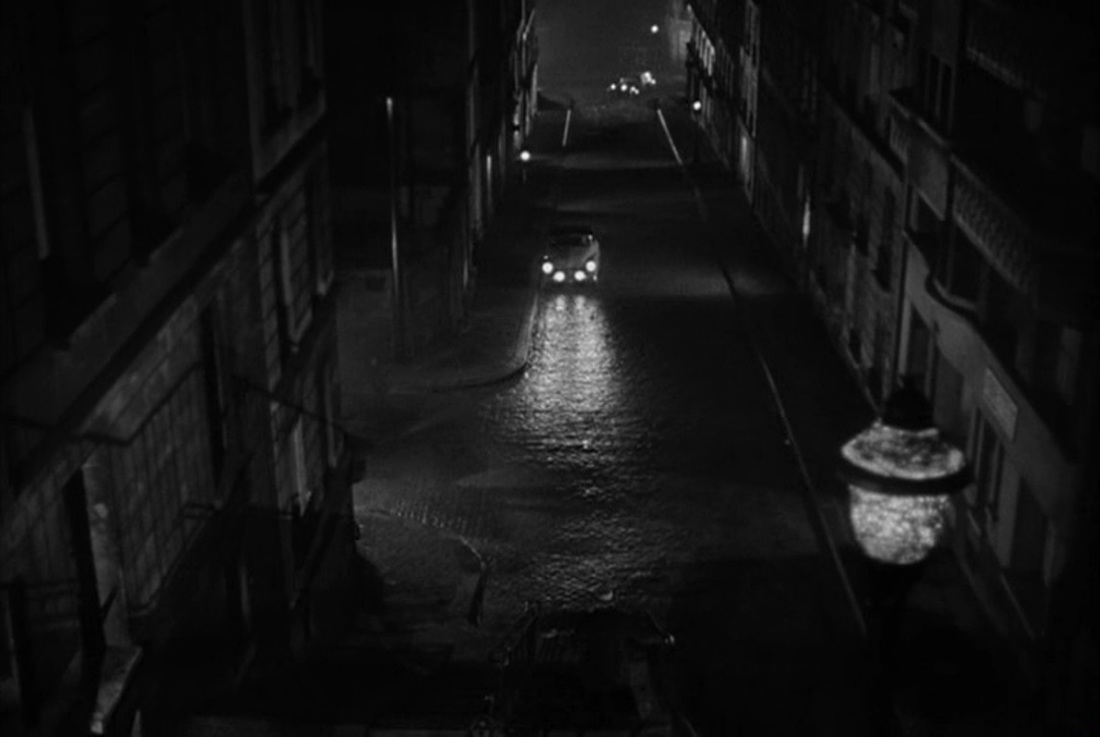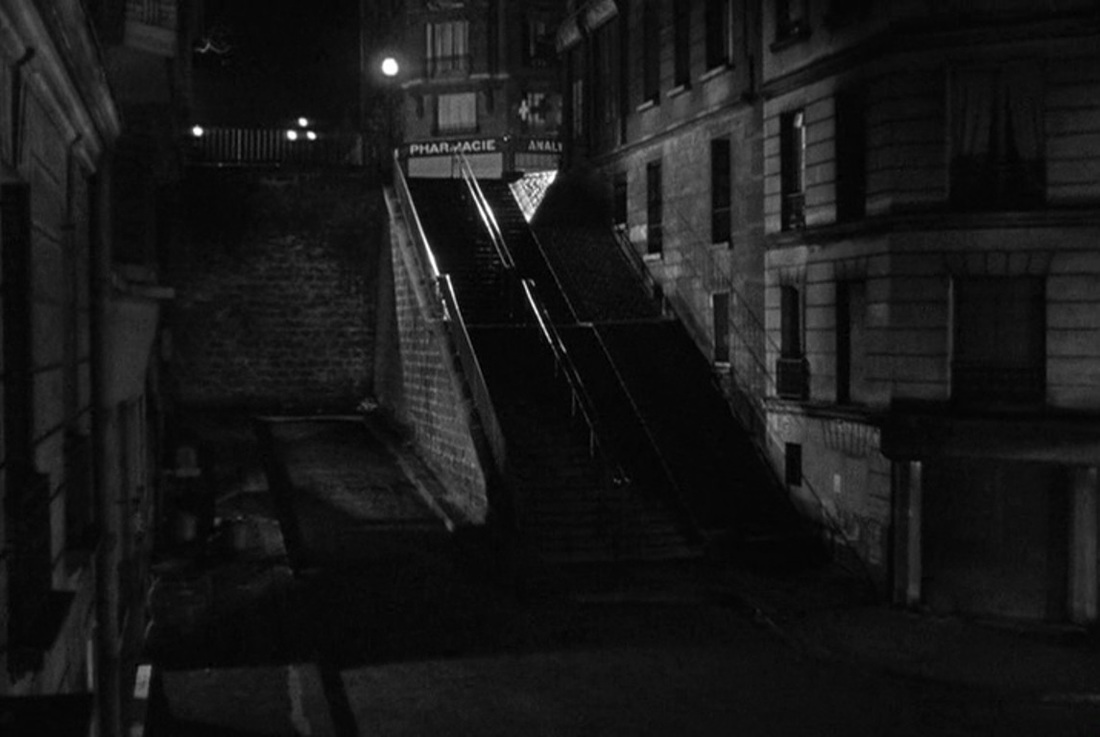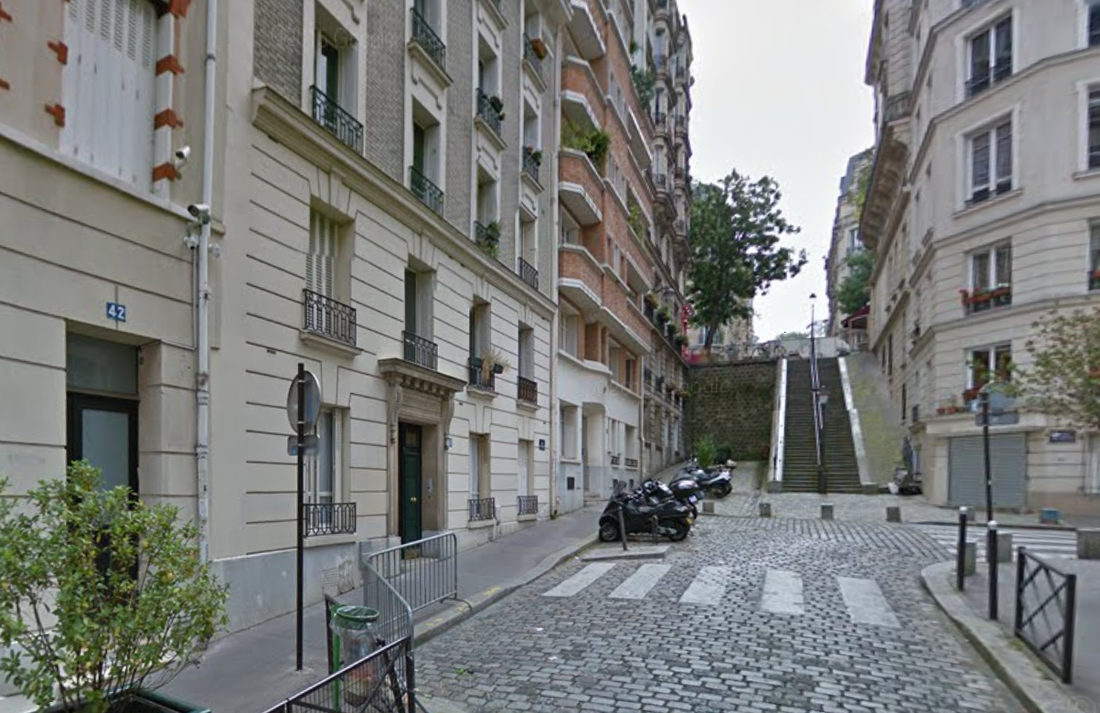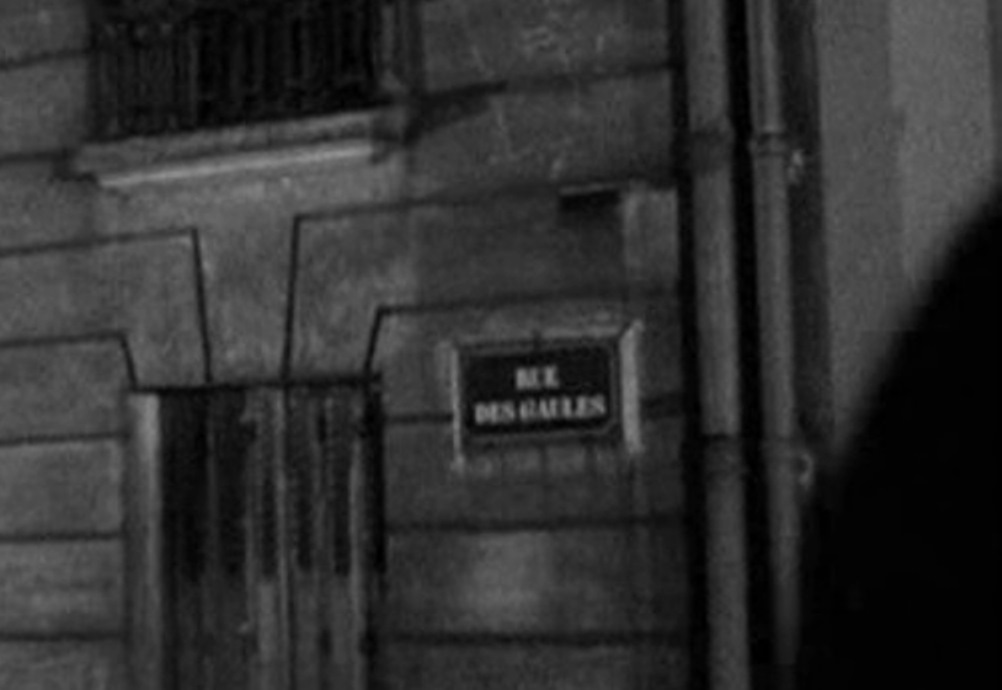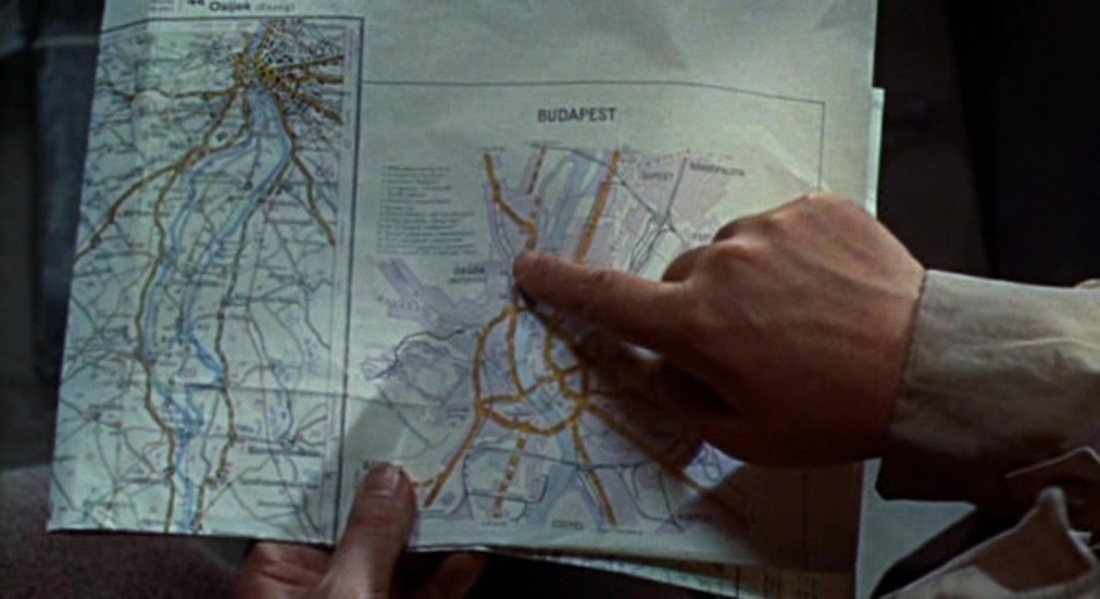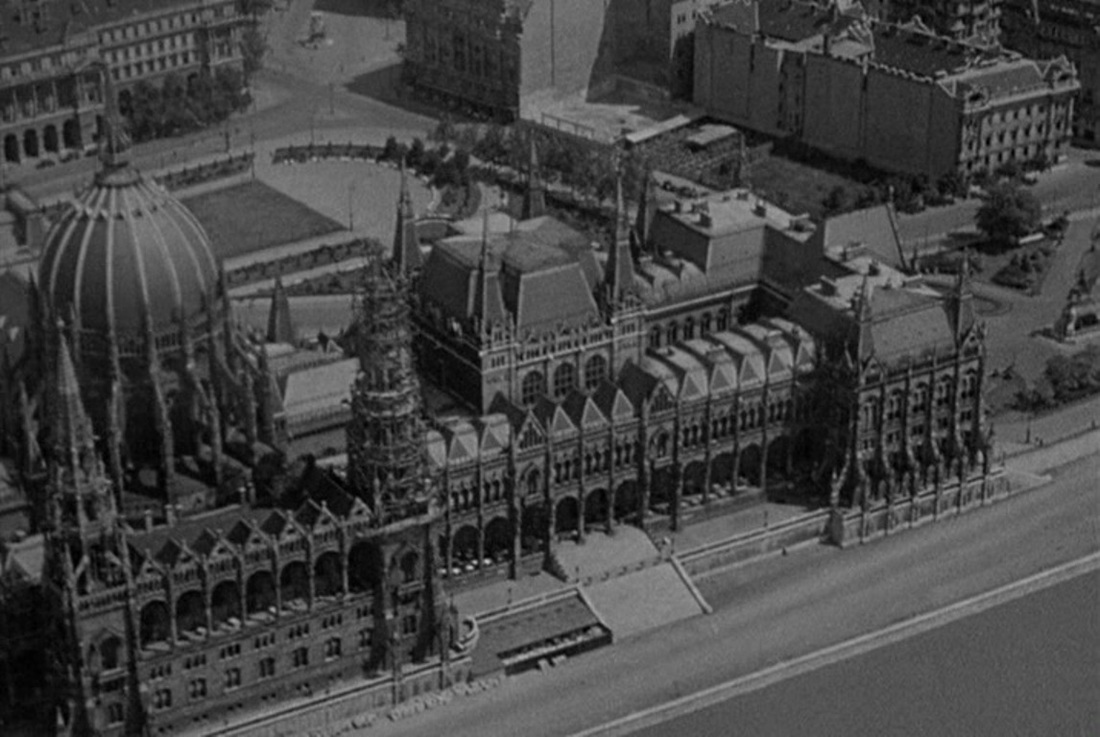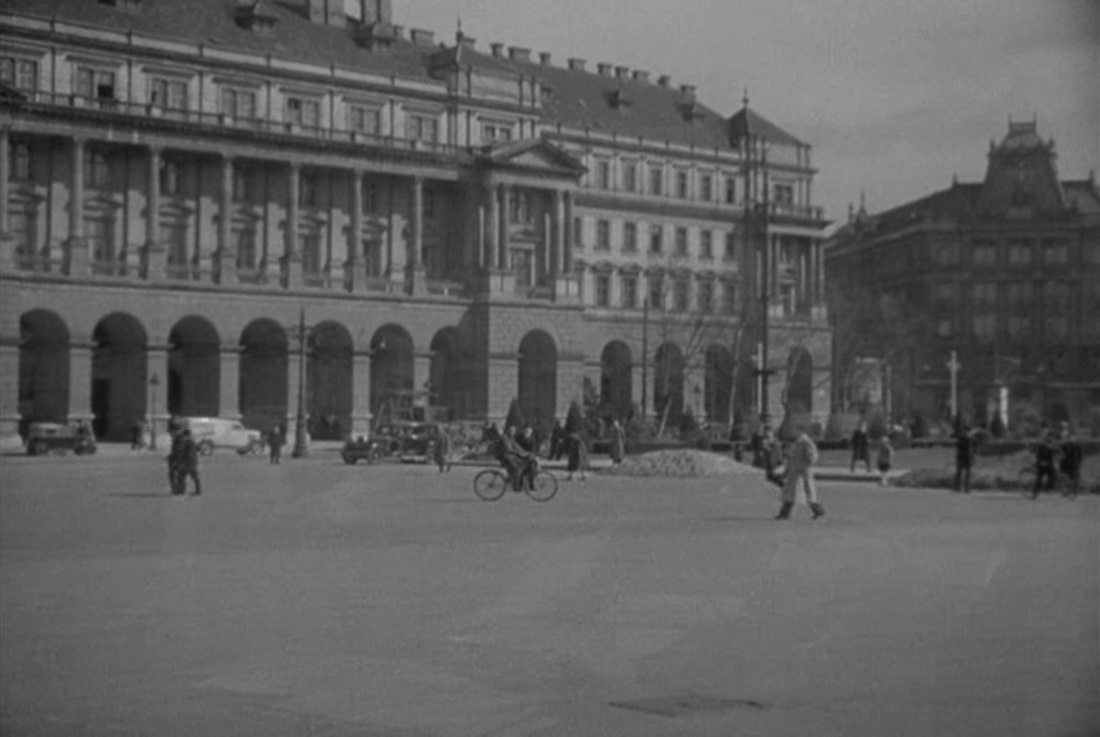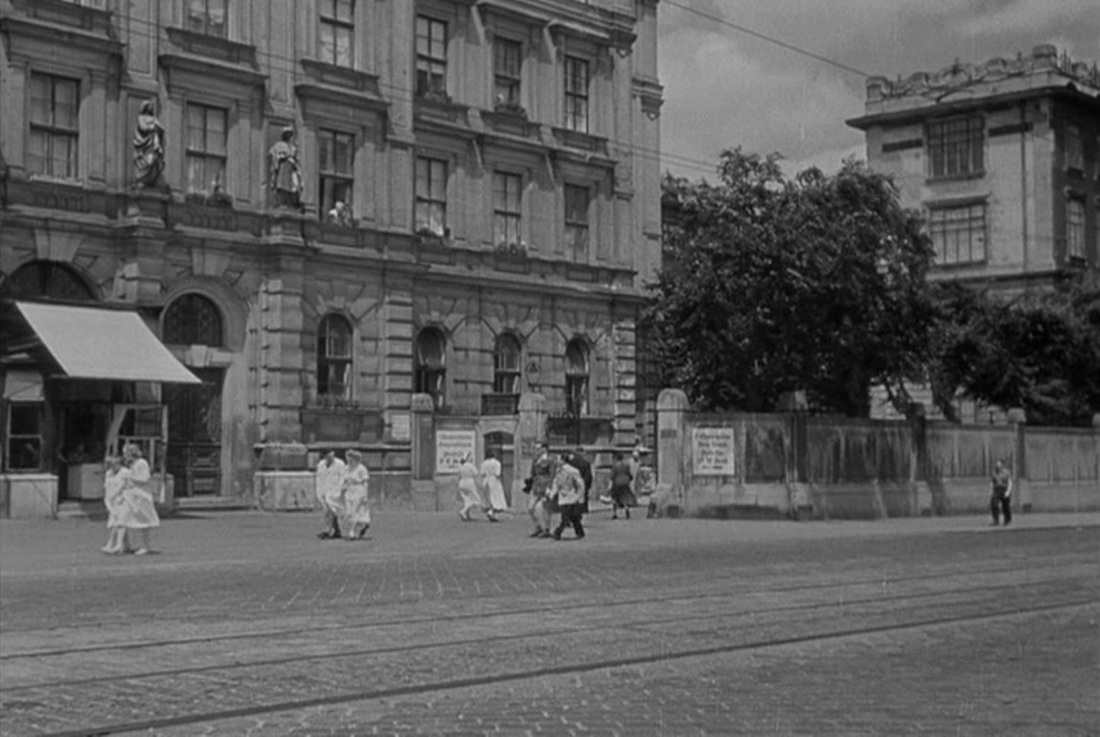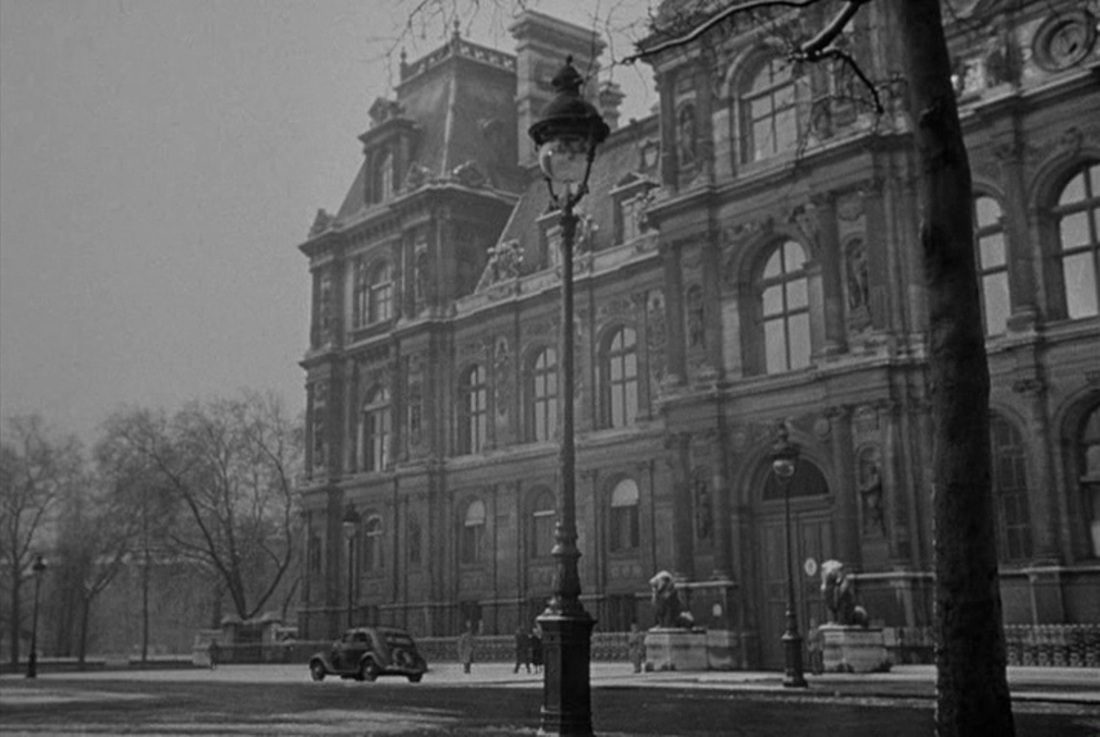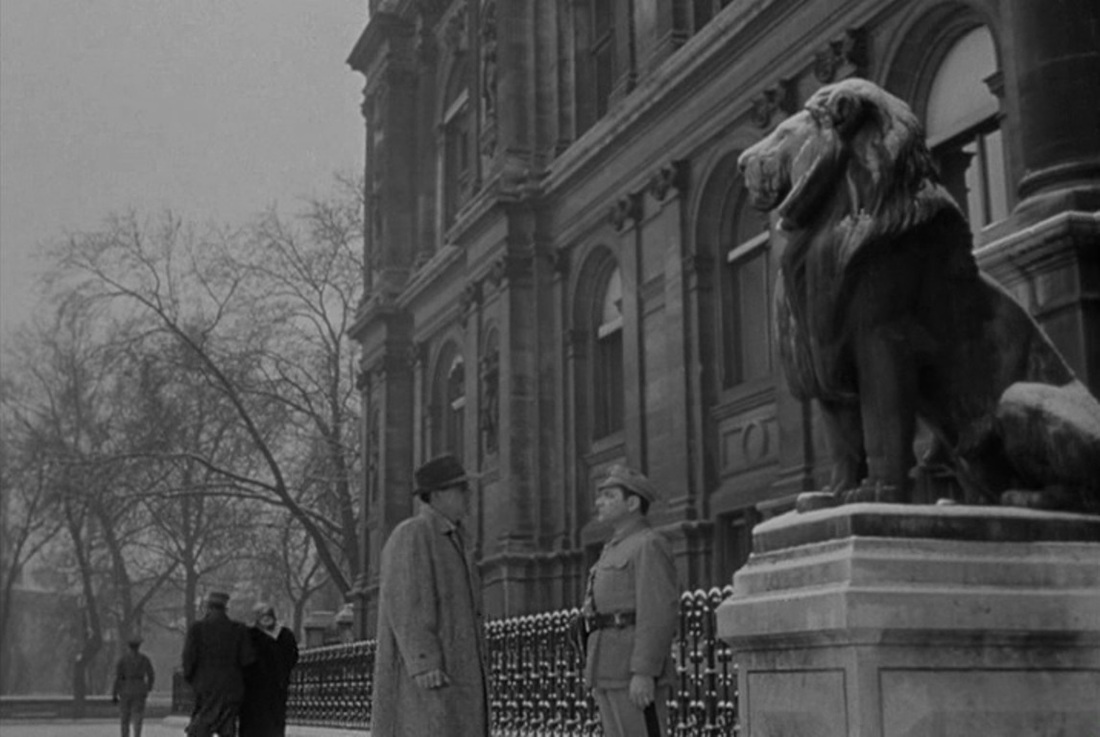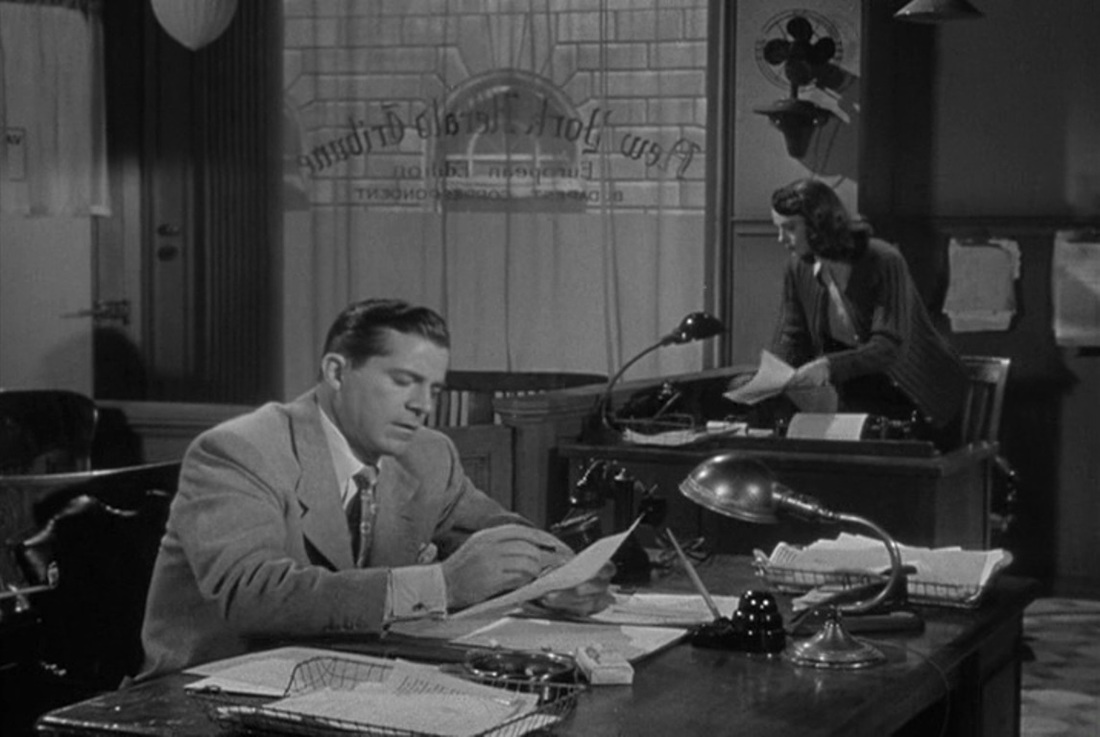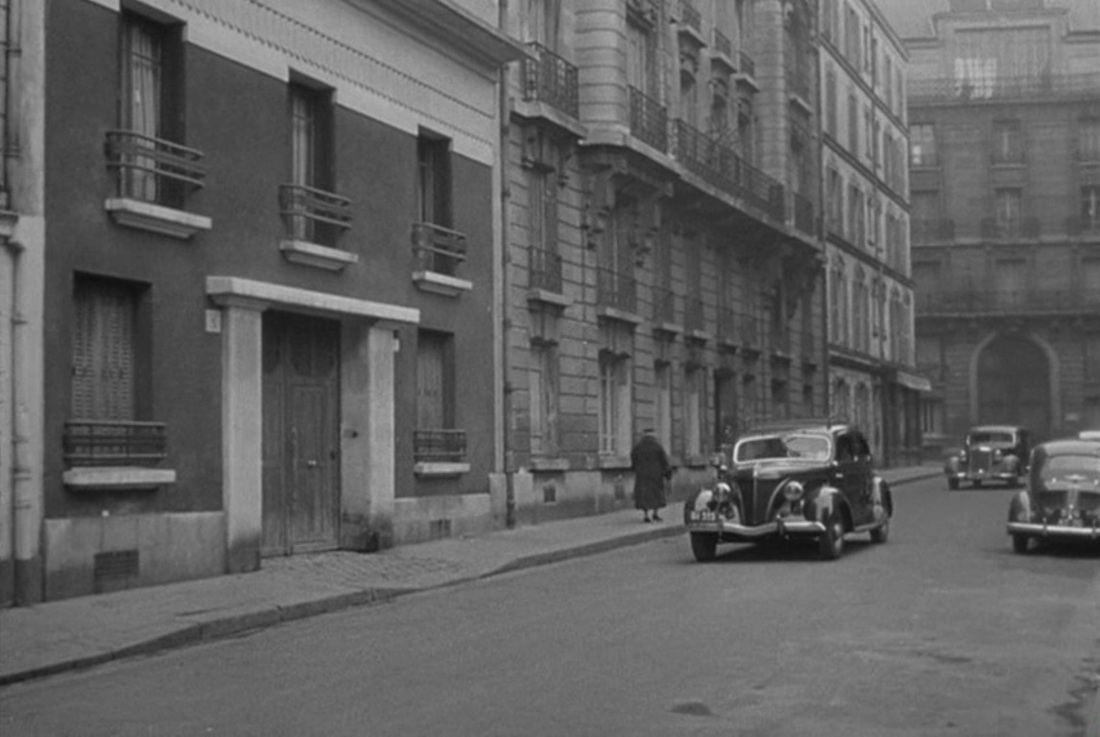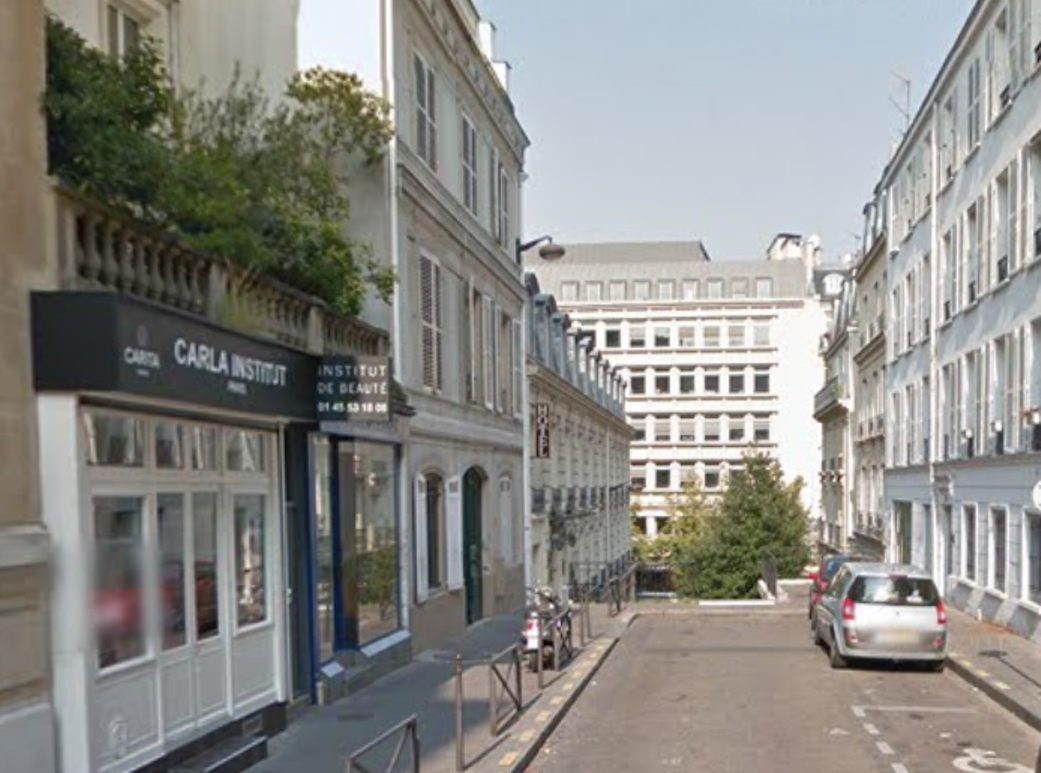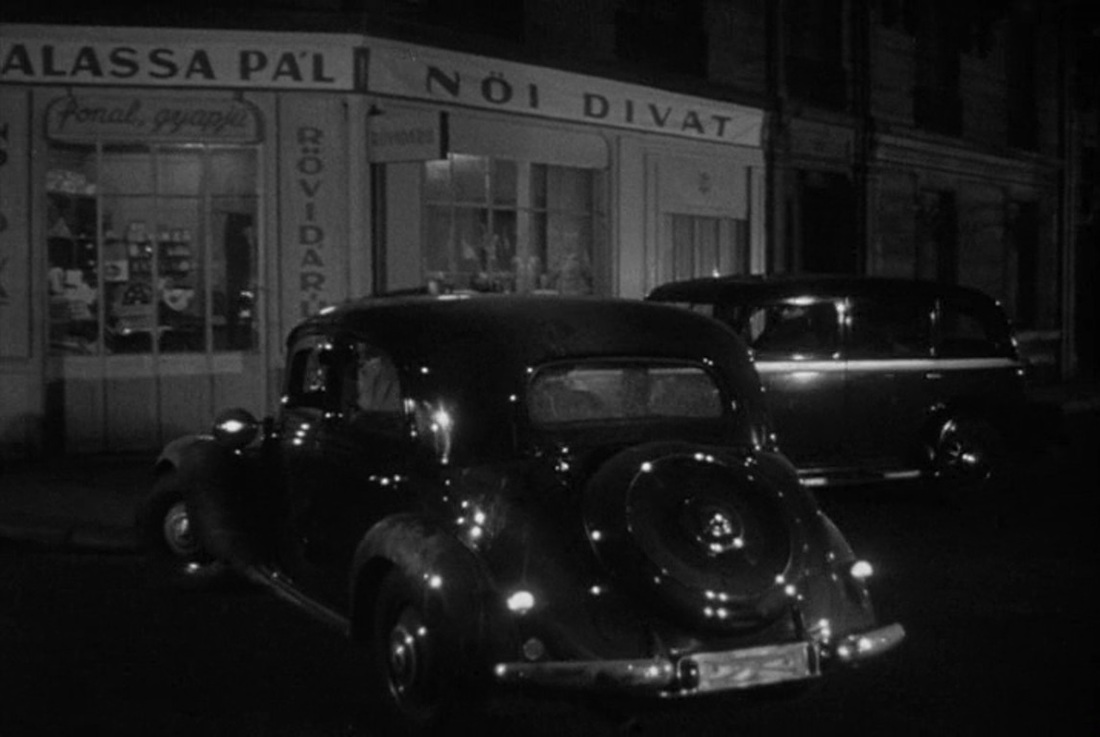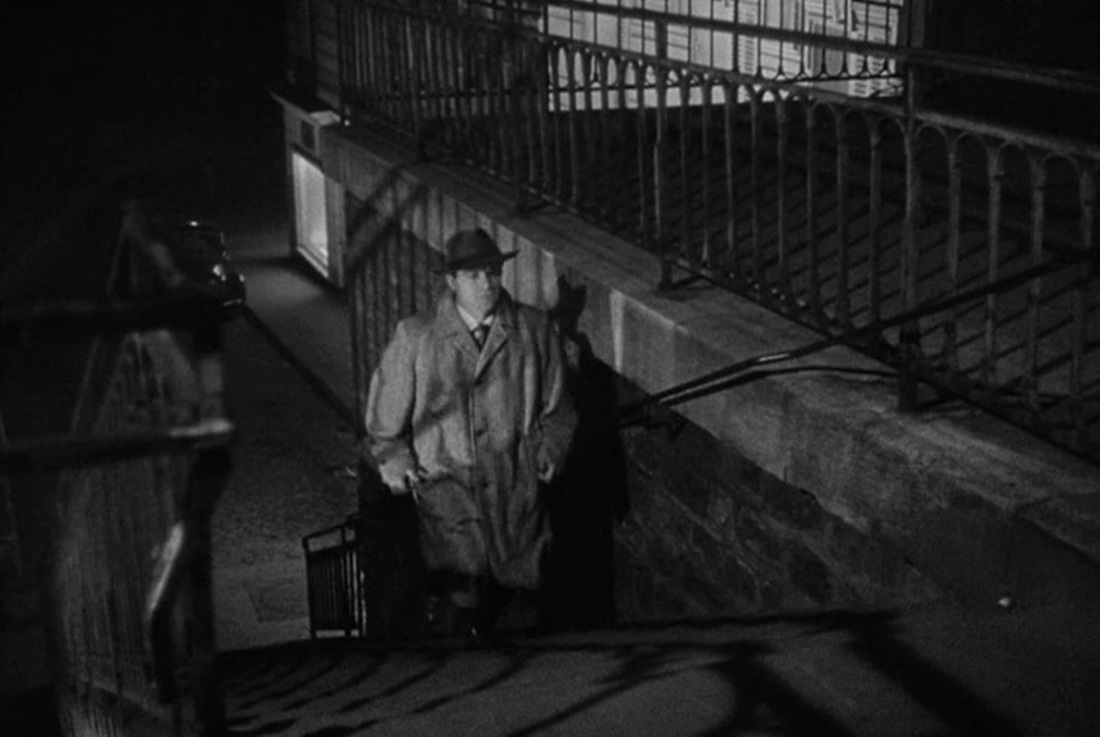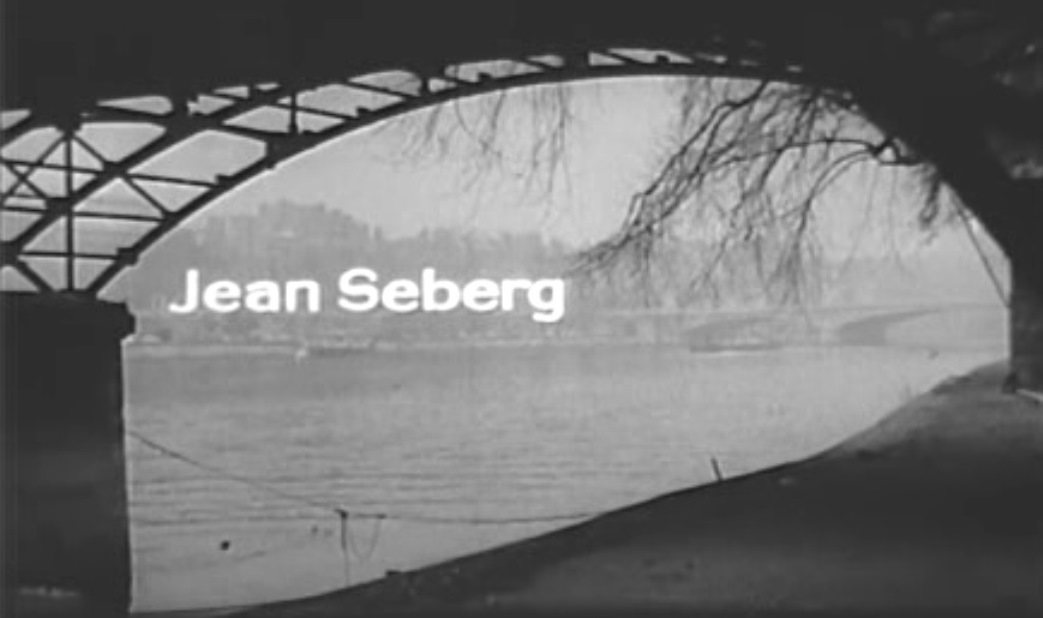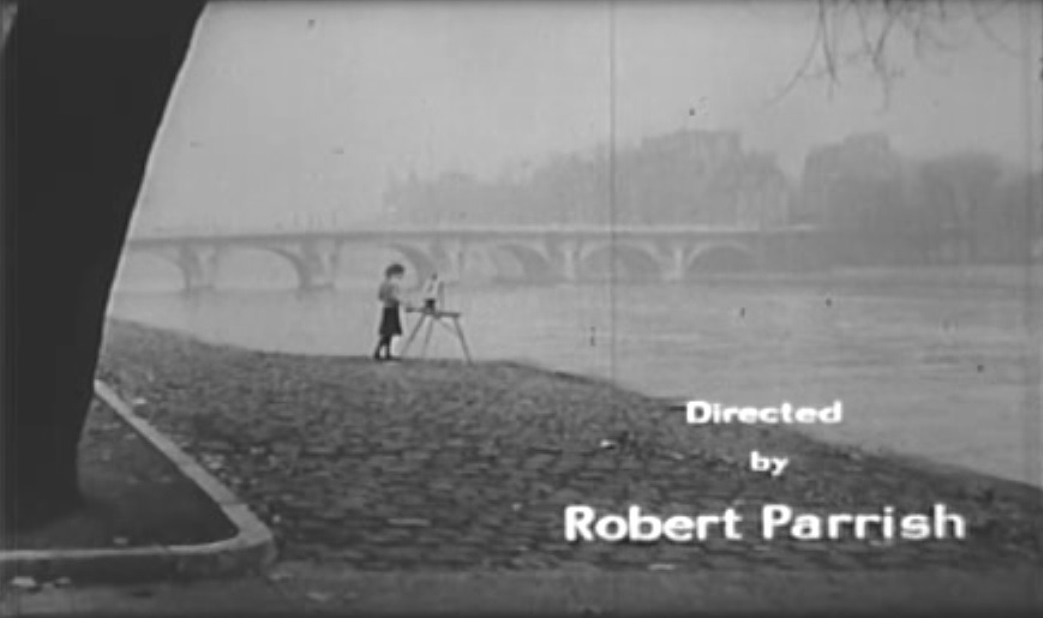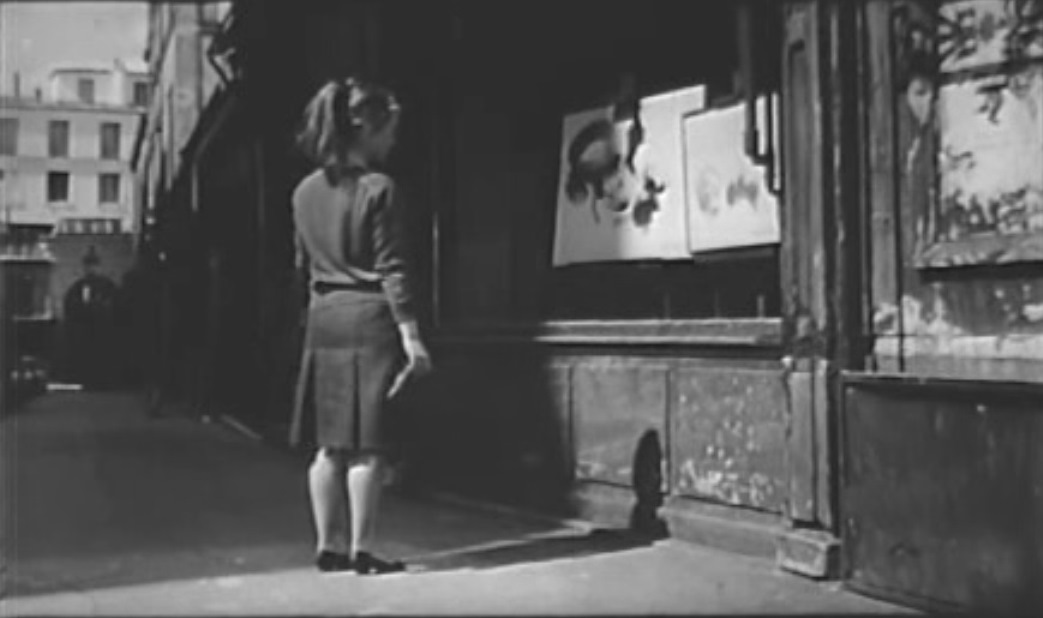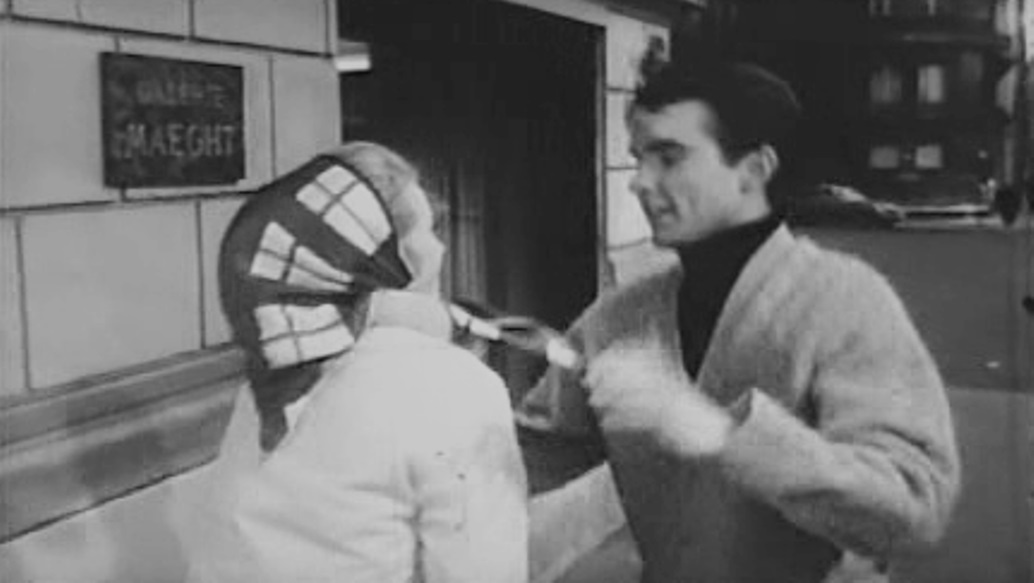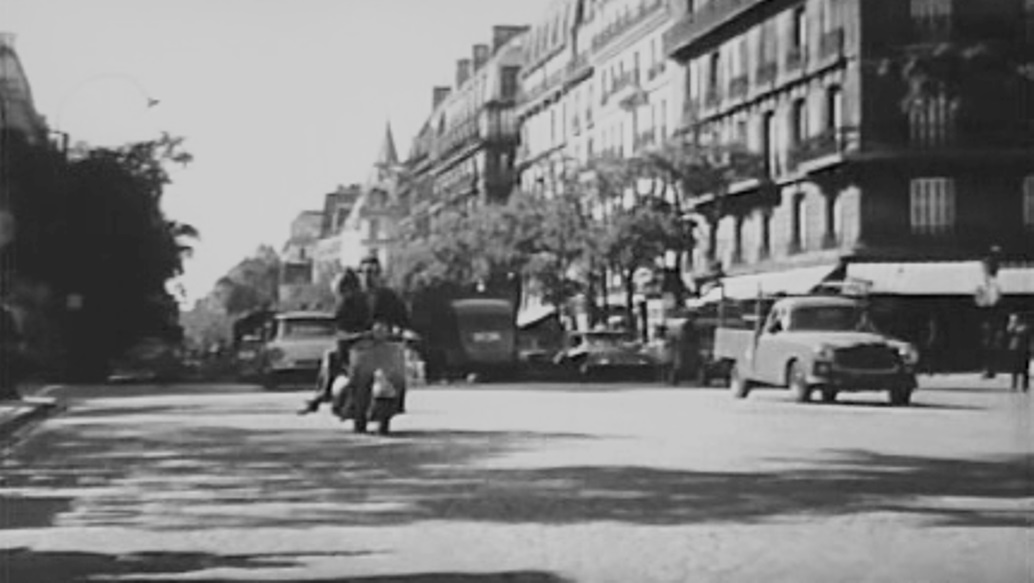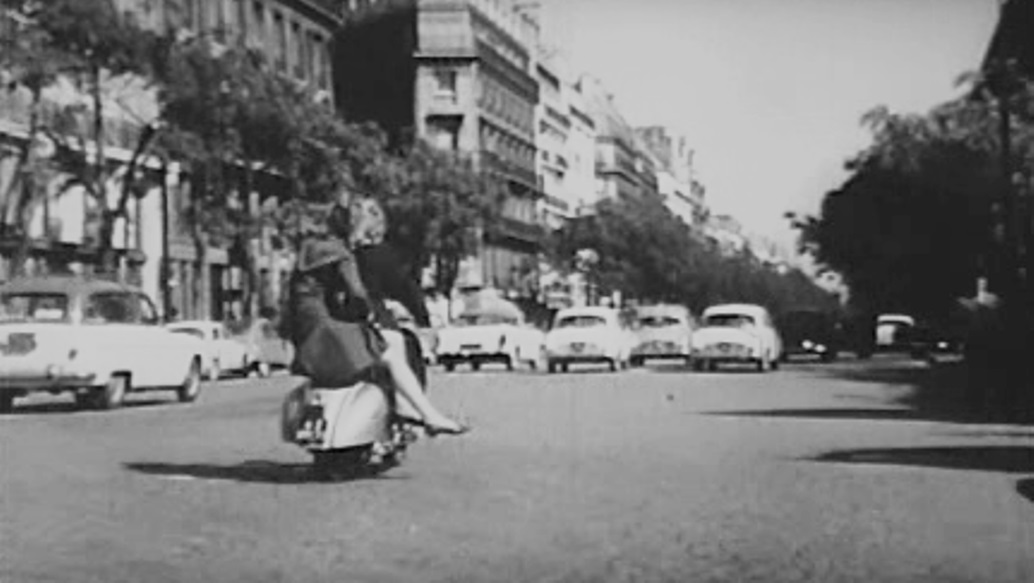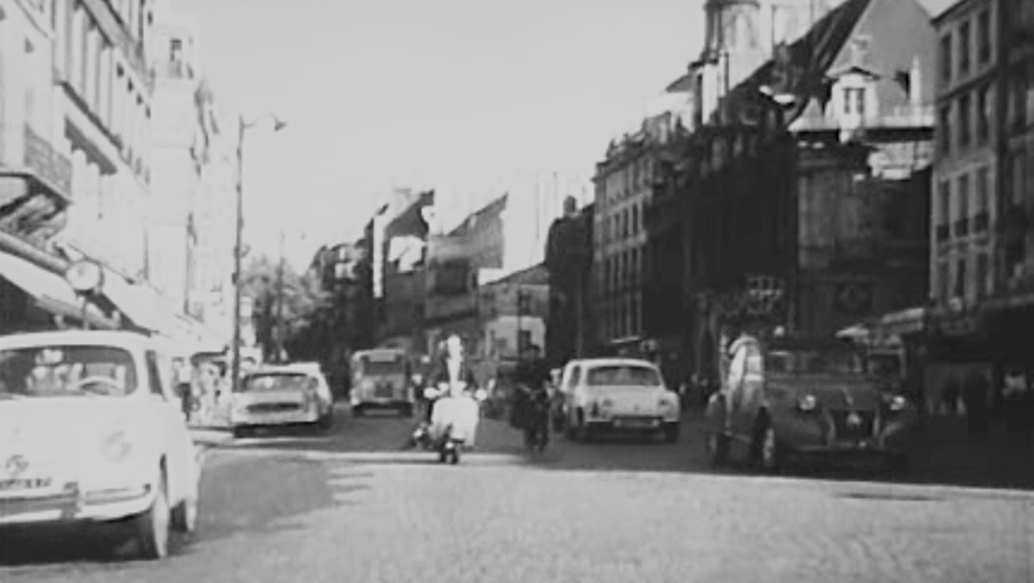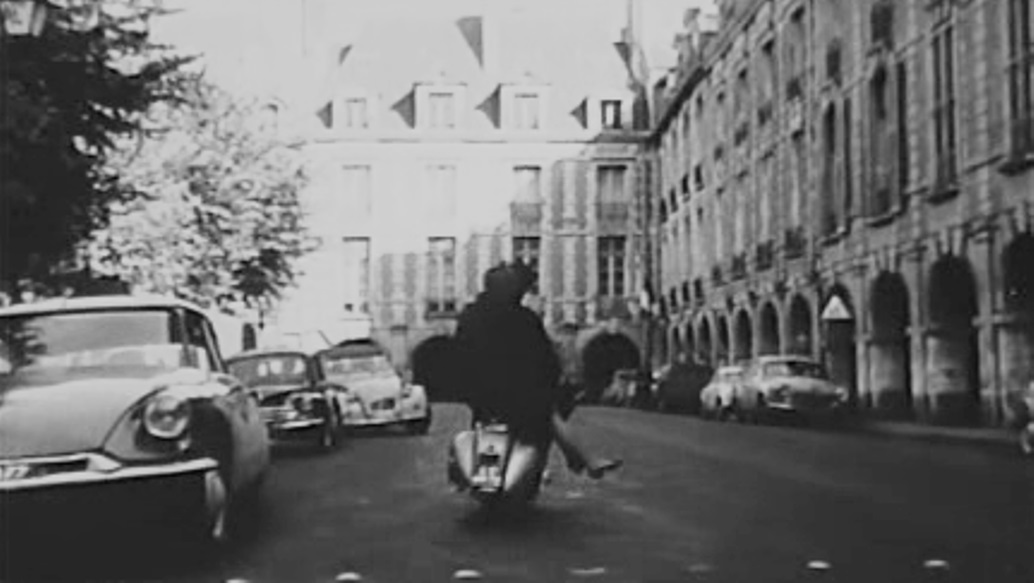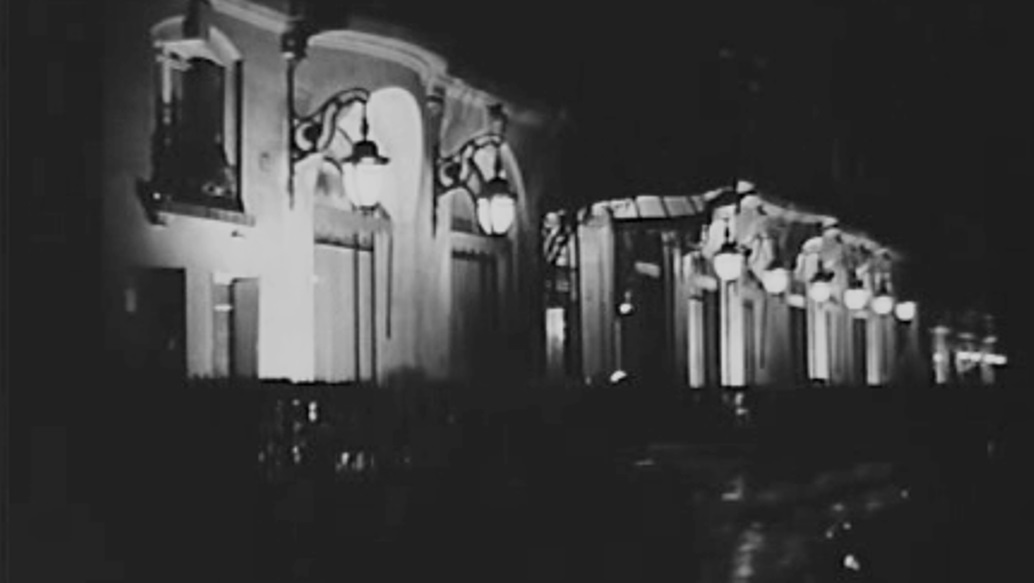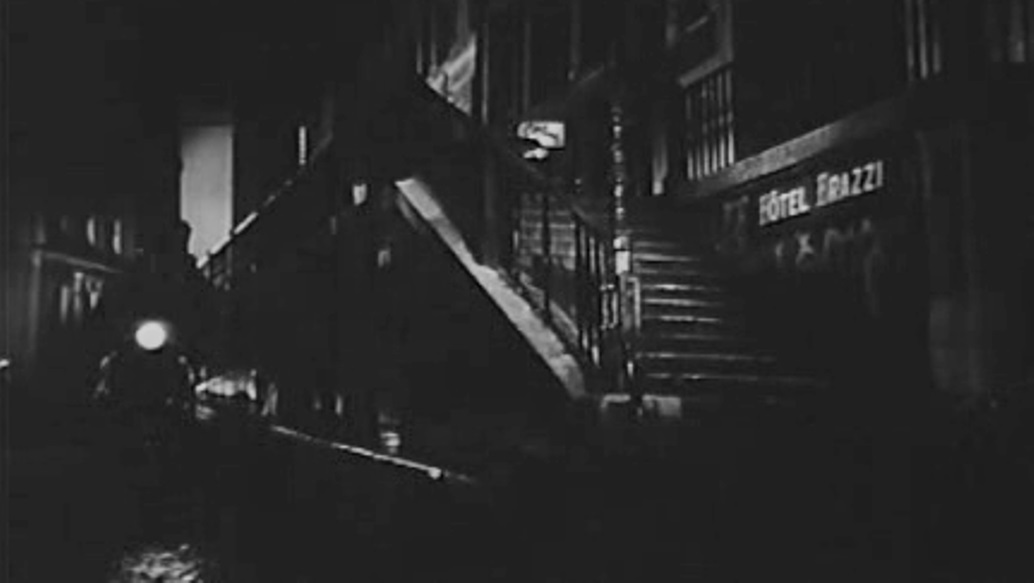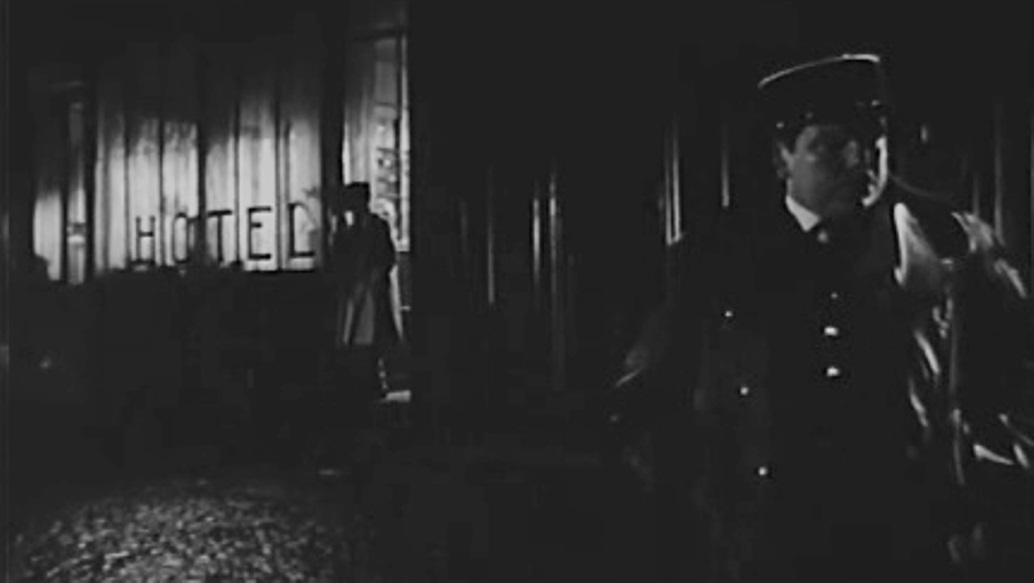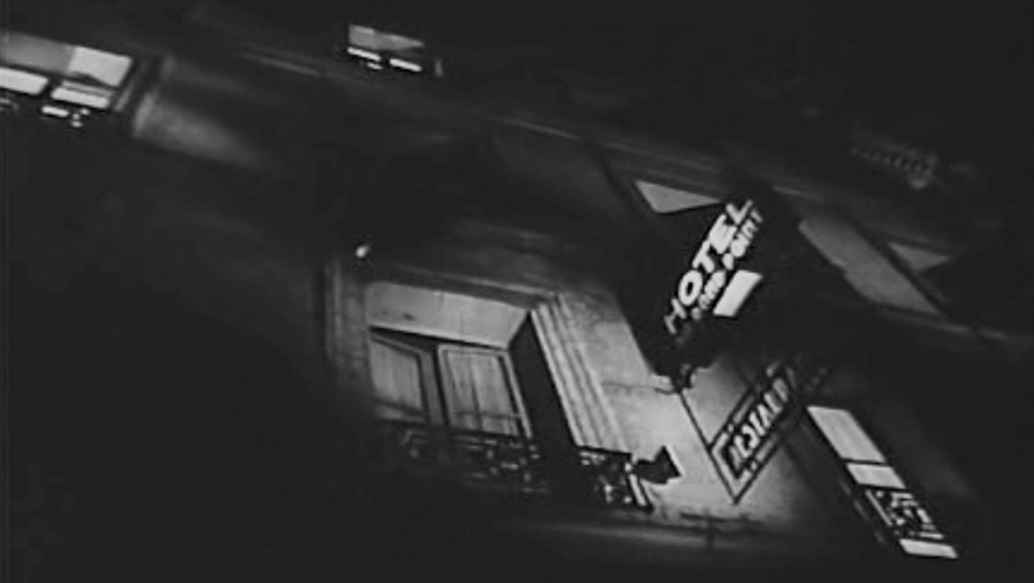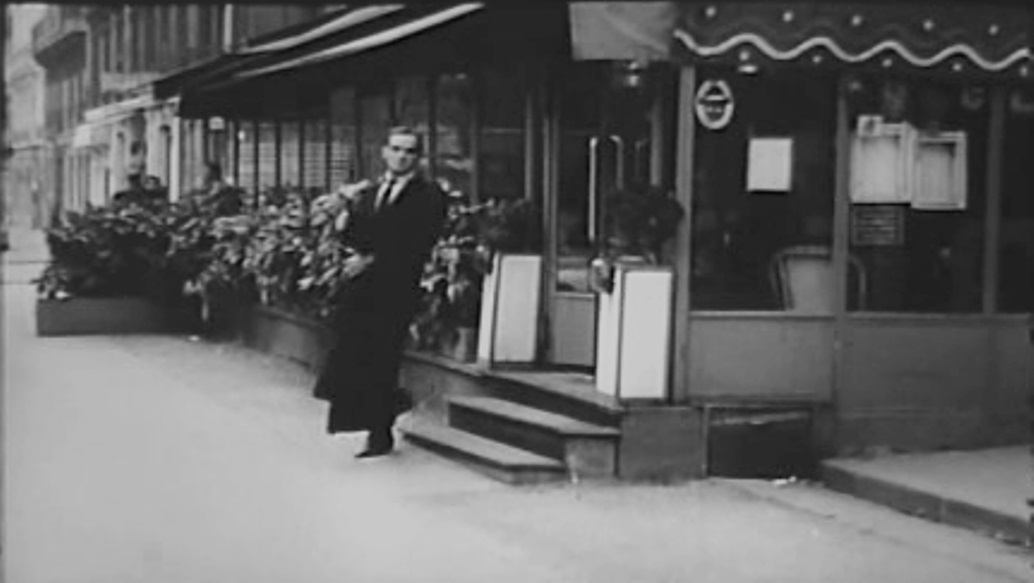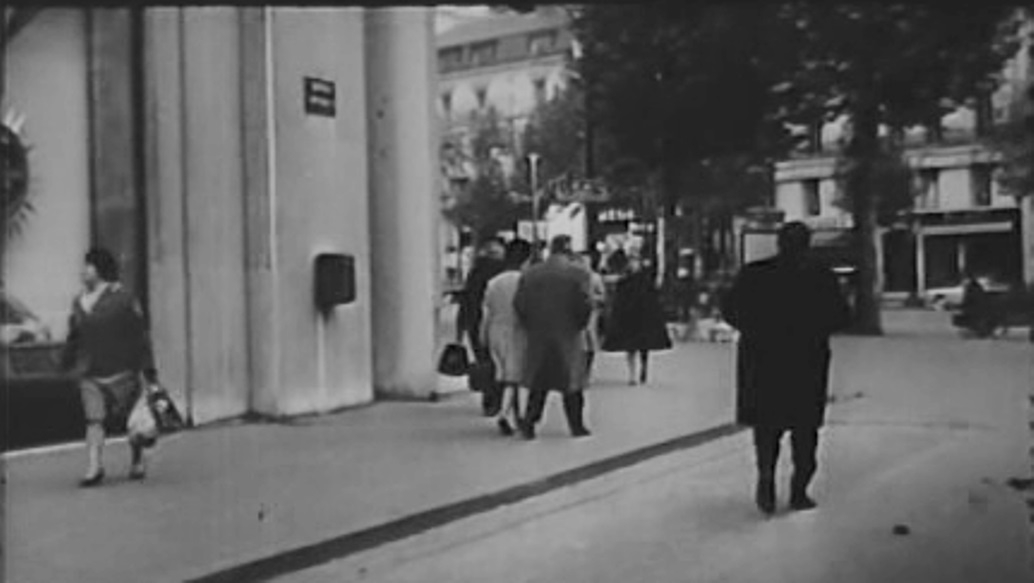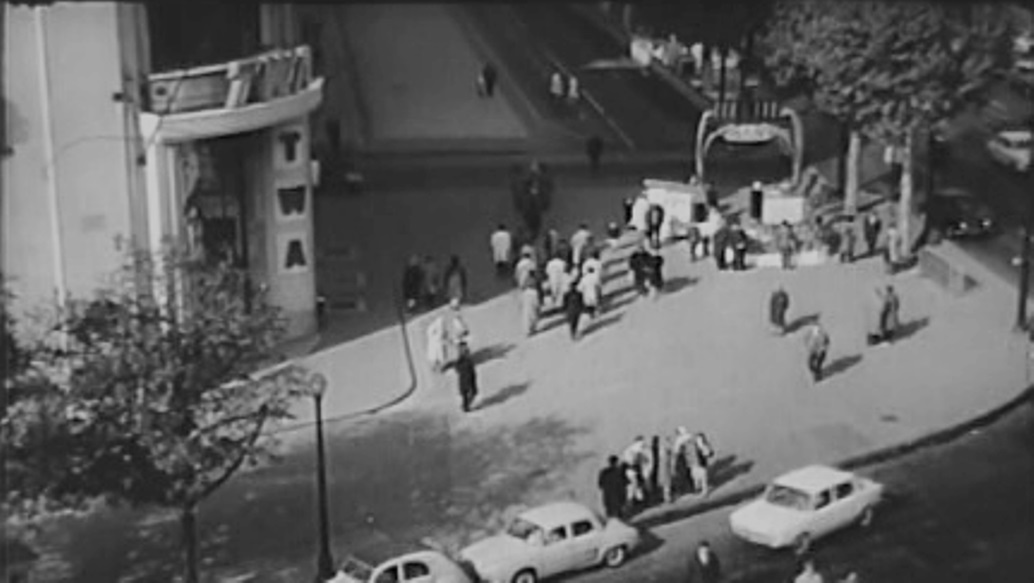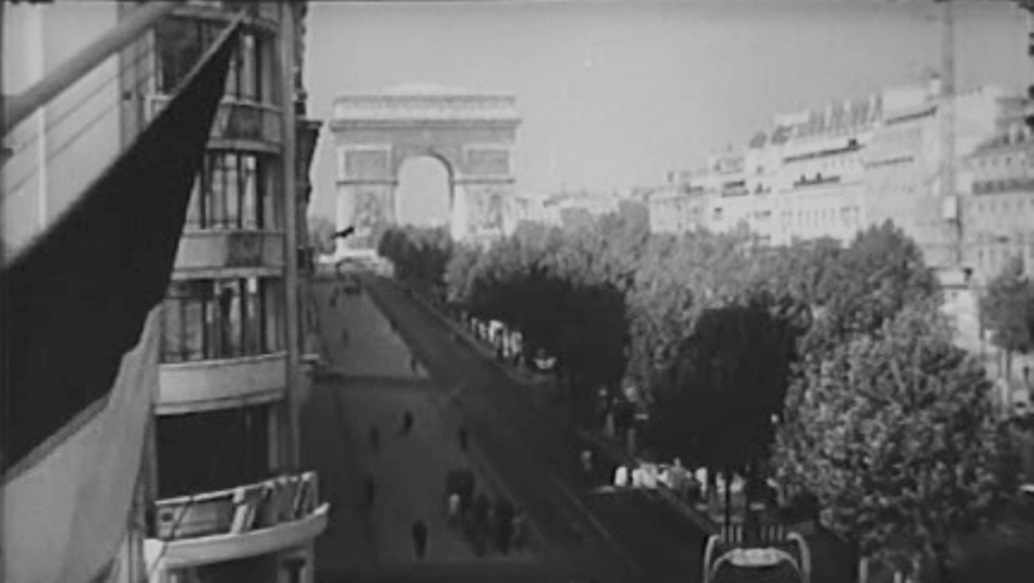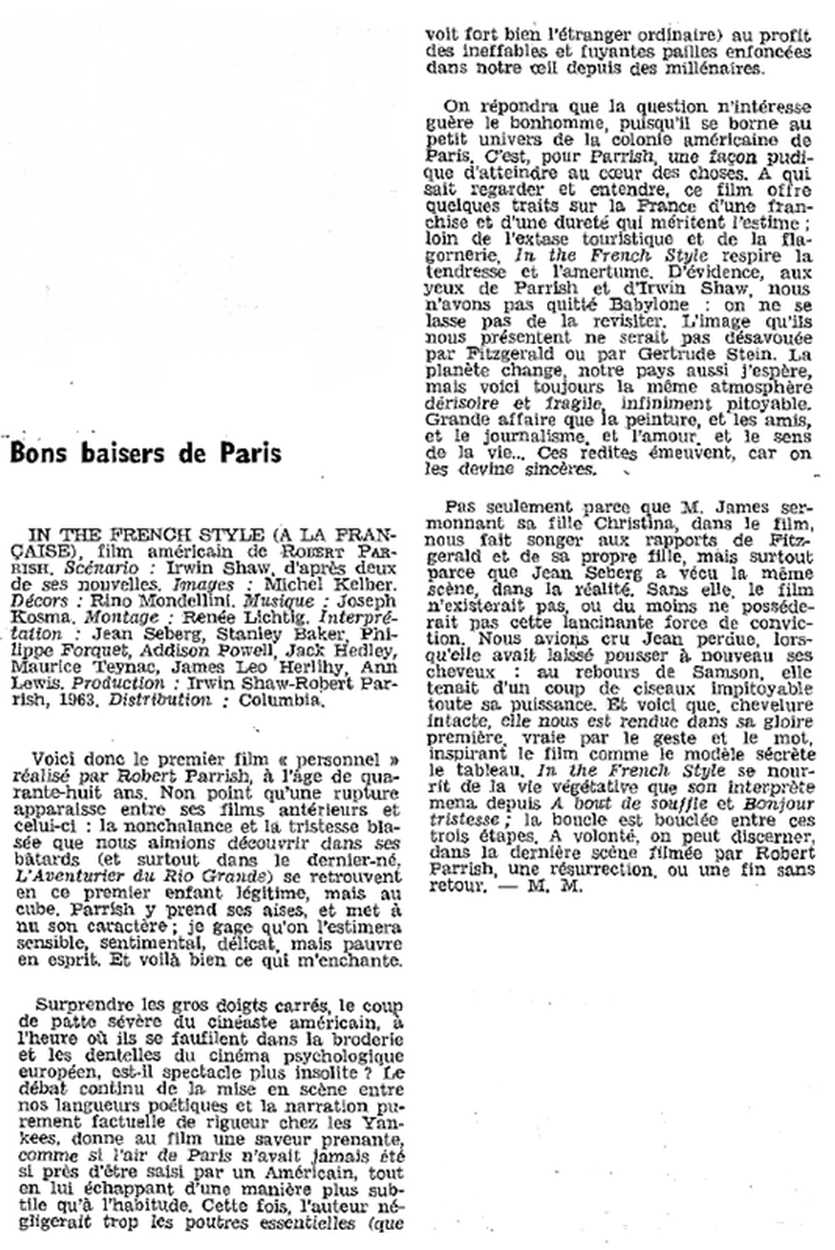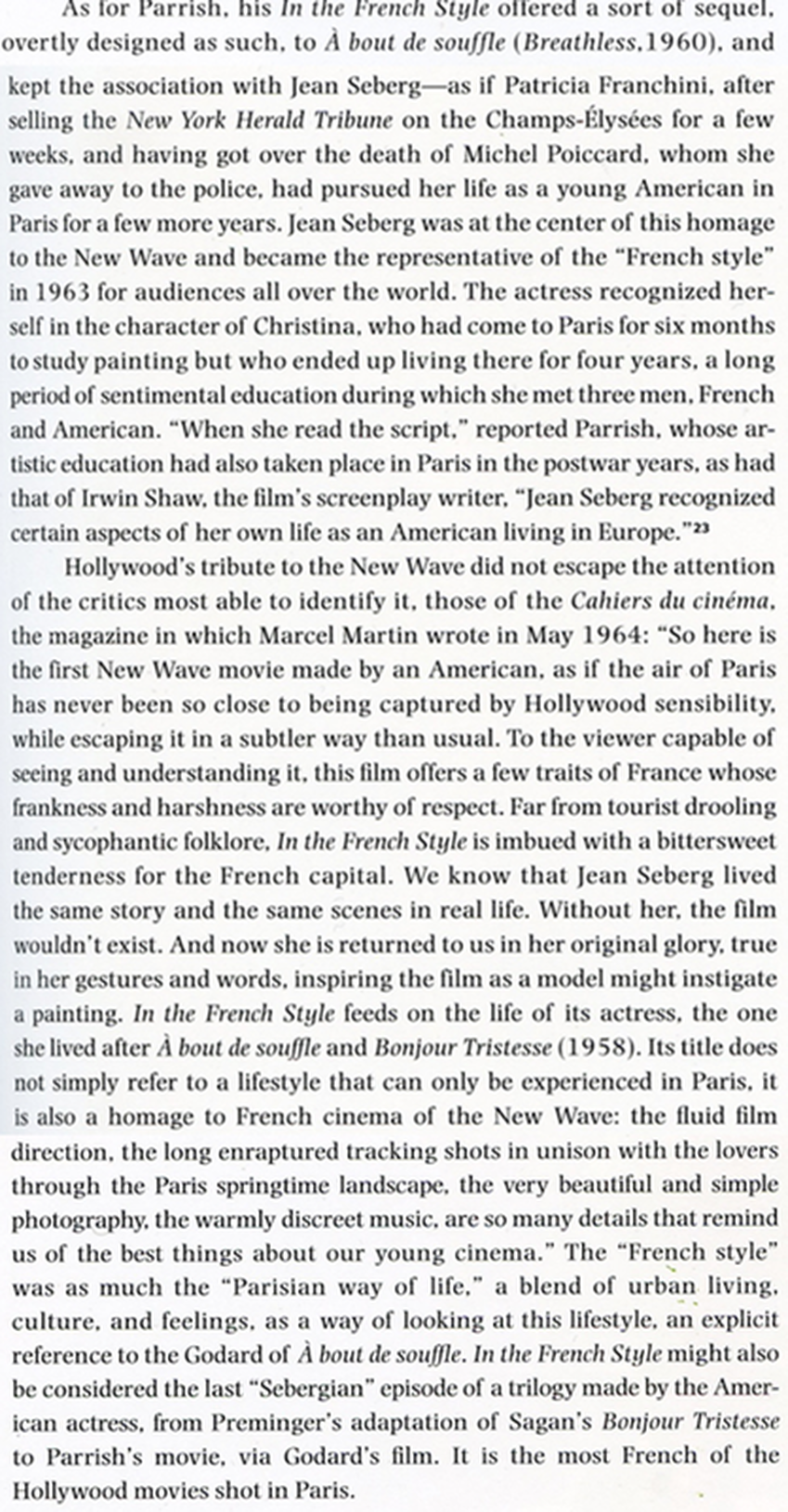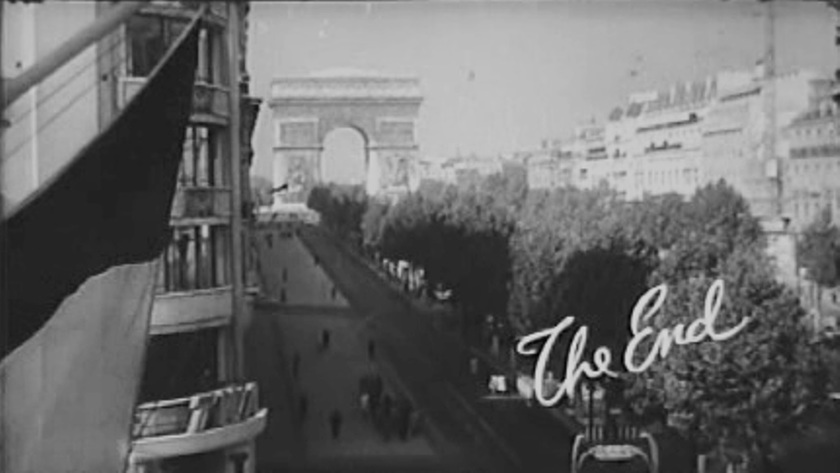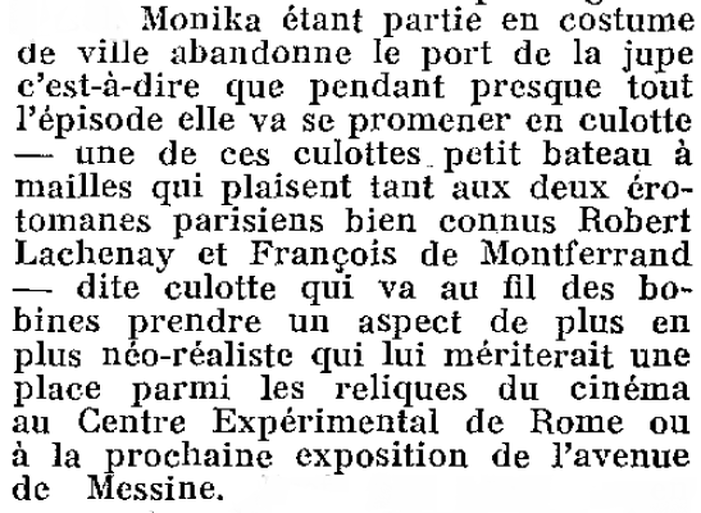'New York Herald Tribune'
- Robert Parrish and Jean Seberg on the rue de Berri
- Robert Parrish and Jean Seberg on the rue de Berri
1/ 1 place 3 films: street as intertext
Different kinds of connection can be established between the appearances in these three films of the Paris offices of the New York Herald Tribune. Whereas the first action of Melville's film is deliberately situated in a street associated with A bout de souffle, Godard's use of the same setting as Parrish's film does not seem to be the signpost of an intertextual connection. It is true that in both Assignment - Paris and A bout de souffle a female journalist is followed when she leaves the newspaper's building, but that I think is a coincidence. On the other hand, Melville's reference to Godard's film keeps up a game of reciprocal quotation that started with the mention of Bob le flambeur (1956) and Melville's own appearance in A bout de souffle and continued with Melville's reprise of Belmondo's look and manner in Le Doulos (1962). In Vivre sa vie (1962) Godard restaged a shot from Bob le flambeur, in exactly the same street that Melville had used (see here). Later in Le Samourai Delon goes from the rue Lord Byron to the avenue des Champs Elysées, as Belmondo had done in A bout de souffle (see here).
My only other sighting of the Herald Tribune is in the 'Saint Germain des Prés' episode of Around the World with Orson Welles (1955), which begins with an exterior view of the building, followed by a scene with Art Buchwald at his desk, preparing a story on Paris After Dark:
I haven't seen Alain Cavalier's 1958 New Wave film Un Américain to know whether it shows the Herald Tribune building. The protagonist is an American sculptor who sells the New York Herald Tribune to make ends meet. It would be interesting to know if this Chabrol-produced short is intertextually connected to A bout de souffle, where the American Jean Seberg sells the New York Herald Tribune to make ends meet.
2/ Seberg: star as intertext
If the New York Herald Tribune in A bout de souffle isn't a reference to Parrish's 1952 Paris film, as a French New Wave homage to Hollywood, it has on the other hand been argued that Parrish's 1962 Paris film In The French Style is a homage to the French New Wave. The conduit of reference is Jean Seberg: 'In the French Style feeds on the vegetative life led by its actress since A bout de souffle and Bonjour Tristesse' (Michel Mardore, Cahiers du Cinéma 155, May 1964). Here we see a direct link between Parrish's film and Preminger's:
By quoting Bonjour Tristesse Parrish has picked up on the game played by Godard, whose Patricia is an explicit reprise of Preminger's Cécile, but he abandons the most obvious signifier of intertextual continuity, Seberg's haircut:
The variety of Seberg's hairstylings in Parrish's film suggests a distancing from the Cécile-Patricia mode which should probably be attributed to the actress rather than the director, and which relates also to her coiffure in her first film, Preminger's Saint Joan (1957):
In the French Style isn't the first of Seberg's Paris films to use coiffure as a distancing device. Here is Seberg in the last shot of De Broca's L'Amant de cinq jours (1961):
Mardore's review of In the French Style expounds at length on Seberg's hair:
|
|
We had thought that Jean was lost to us, once she had grown back her hair: like a Samson in reverse, all of her strength had come from a pitiless application of the scissors. And yet here, with her chevelure intact, she is restored to us in all her first glory, authentic in gesture and speech, inspiring the film as the secret model inspires a painting.
|
(Actually I had assumed that here and in L'Amant de cinq jours Seberg was wearing a wig.)
3/ 1 film 2 places: Paris
Aside from several views of the rue de Berri, the Paris of Parrish's film features several familiar locations. The credits appear over shots of the Arc de Triomphe and the Eiffel Tower, viewed from the avenue d'Eylau:
Filmed before development in the 1950s and early '60s, Orly airport looks rather small scale compared with, for example, the same airport in In the French Style:
The Hungarian Embassy is an important setting for the film's action. It was probably not politically feasible to show the actual exterior of the Embassy, so a substitute is used, at 1 rue Brignole:
Even if it had been acceptable to show the real embassy building, that would have been topographically awkward for the narrative, since the Hungarian Embassy at the time was at 15 rue de Berri, three doors down from the Herald Tribune offices. The film avoids showing the embassy - the building is just beyond the left edge of the frame, here:
The building can be seen at the edge of the frame, here, eight years later:
Jeanne (Märta Torén) lives here, somewhere in the 16e arrondissement, I would guess:
She has a tryst with the Jimmy (Dana Andrews) on the pont Saint Michel, against a Notre Dame backdrop:
Their car journey from the Herald Tribune offices to the United Nations building takes a circuitous route. From the Arc de Triomphe they head west along the avenue Foch (back-projected), but then are on the place de la Concorde, which they would have reached by going in completely the opposite direction, east along the avenue des Champs Elysées:
The effort to connect the two landmarks again, as they were in the opening credits, makes the journey between them incoherent, but this is less of a problem for the topographically aware viewer than the fact that their journey ends in front of a wholly unfamiliar building that is apparently right in front of the Palais de Chaillot:
This, I was astonished to learn, is a temporary structure built to accommodate delegates to the United Nations in 1951:
The buildings later hosted early NATO meetings. I'm not sure when exactly they were removed; they were still there when Donen shot Funny Face in 1956 but had gone when Quine made Paris - When It Sizzles in 1964:
The last Paris location of Assignment - Paris, where the climax of the drama is played out, is at an address given as '10 rue de Gaule' but which is actually 40 rue des Saules, in Montmartre:
The change of name is a very thin disguise; the 'S' of 'rue des Saules' is replaced on the street sign with a 'G':
This is not, actually, the only disguised Paris location in Parrish's film.
4/ 1 film 2 places: Budapest
After thirty-five minutes the action shifts to Budapest, a location introduced by an overhead view of the Hungarian parliament:
This is a stock shot, as is a view of the building behind the parliament seen two minutes later:
Another stock shot is shown five minutes later. This is supposed to be near a hospital, but I haven't been able to locate this street in Budapest. All suggestions welcome, here:
This is all we see of Budapest itself. Every other exterior view is of Paris disguised as Budapest. On arriving Jimmy has to report to the Ministry of Justice:
What we see in the film is not the neo-classical edifice above but the neo-Gothic rear façade of Paris's Hôtel de Ville, rue de Lobau:
The Budapest office of the New York Herald Tribune at ('17 Vaci Utca') is only shown from the inside, though a real street, which I suppose is in Paris, can be seen through the window:
The most developed Budapest location is a tailor's shop on a street that ends in a staircase:
This is no 7 rue du Dôme, 16e:
Later a car accident is staged at the top of the rue du Dôme:
After the accident Jimmy walks up the rue du Dôme stairs, which is topographically unfeasible but escalographically aesthetic:
5/ Parrish's Paris c.1962
The poor quality of the print I have of In the French Style makes it hard to identify all of the locations, so this is not a complete account of the film's topography.
Behind the credits the camera pans over the Seine by the pont des Arts:
Other locations include an art gallery on the rue Jacques Callot (Bernier, I think) and a gallery on the avenue de Messine (Maeght):
A scooter ride through the streets of Paris ends up at the place des Vosges:
A night-time scooter ride to find a suitably tawdry hotel is more interesting, but the hotels are hard to localise. The one with the stairs is on the rue Malebranche, 5e:
For the last twelve minutes of the film Jean Seberg and Stanley Baker are in a bar on the avenue George V. We follow Baker out of the bar and onto the Champs Elysées, and the film ends with an overhead view of the Champs towards the Arc de Triomphe:
6/ the Cahiers du Cinéma review of In the French Style
There is a mystery to clear up regarding the review of Parrish's film, quoted above re. Jean Seberg. I translated the extract myself, even though Antoine de Baecque quotes the same article at length in the catalogue of the 2012 exhibition Paris vu par Hollywood, which is available in an English translation. I haven't been able to use that translation because the text quoted doesn't correspond exactly to the original Cahiers du Cinéma article. Here is Mardore's review:
Here is Baecque's text (for the original French click on the text):
The first problem is that Baecque attributes the article to Marcel Martin. It is signed 'M.M.', and a note at the end of this section of reviews deciphers those initials:
To confuse Michel Mardore and Marcel Martin is understandable, though you might think a former editor of Cahiers du Cinéma and author of a 700-page history of the journal would be able to distinguish a long-term contributor to the Cahiers (Mardore) from someone who had never published in that journal (Martin).
A bigger problem is that the text attributed by Baecque to Martin deviates from the Cahiers du Cinéma review in several ways. As well as some modifications of the syntax there are two substantial sections added, presumably by Baecque himself. Here is the passage he quotes (for the English translation click on the text):
The added sections are the opening statement: 'So here is the first New Wave movie made by an American', and the long closing comment on the title of Parrish's film, In the French Style: 'Its title does not simply refer to a lifestyle that can only be experienced in Paris, it is also a homage to French cinema of the New Wave: the fluid film direction, the long enraptured tracking shots in unison with the lovers through the Paris springtime landscape, the very beautiful and simple photography, the warm discreet music, are so many details that remind us of the best things about our young cinema.'
It looks like Baecque has mixed together two separate reviews of the film. If the other is a review by Marcel Martin (in Cinéma 64 perhaps), that would explain the confusion about the name, though that seems unlikely, given that Martin was habitually hostile to the New Wave and would not consider an American homage to the New Wave as something to value. If anyone has an idea where the added phrases come from I would very much like to know, here.
Anyway, whoever wrote the phrases added by Baecque to Mardore's review, the view expressed is completely wrong. In nothing but the most superficial sense could In the French Style be said to be influenced by the New Wave, and there is nothing in it that could pass as a homage. It is just another sentimental melodrama in the manner of Litvak's Goodbye Again or Ritt's Paris Blues (both 1961). Baecque's own conclusion, that Parrish's film 'is the most French of the Hollywood movies shot in Paris', is a weak point rendered spurious by the citation of fallacious evidence.
Anyway, whoever wrote the phrases added by Baecque to Mardore's review, the view expressed is completely wrong. In nothing but the most superficial sense could In the French Style be said to be influenced by the New Wave, and there is nothing in it that could pass as a homage. It is just another sentimental melodrama in the manner of Litvak's Goodbye Again or Ritt's Paris Blues (both 1961). Baecque's own conclusion, that Parrish's film 'is the most French of the Hollywood movies shot in Paris', is a weak point rendered spurious by the citation of fallacious evidence.
One obvious explanation of the mystery is simply carelessness on Baecque's part. This seems all the more likely given that at the beginning of the same essay Baecque quotes in very casual manner a review by Serge Parmion of Wilder's Love In the Afternoon (from issue 73 of the Cahiers du Cinéma), leaving out some words and adding others, including the following statement: 'l'irréalisme de son optique rend caduc tout ce qu'il nous montre, les personnages comme la ville et les situations' ['the unrealism of his angles cancels out everything he shows, the characters as well as the city and the situations']. Parmion's original text reads thus: 'l'irréalisme de son optique rend imprécise la psychologie des personnages, brumeuse leur situation réciproque'. I cannot comprehend why Baecque has transformed the text he quotes in this way, but then again I cannot comprehend why he attributes to Wilder the statement by William Wyler regarding how boring he found Resnais's Last Year at Marienbad, nor why he attributes to Godard a statement regarding Vadim's Sait-on jamais that Godard doesn't make ('The real film of 1957 in 1957'), nor why he says that the title of Doniol-Valcroze's review of Huston's Moulin Rouge is 'le pittoresque', when that review is entitled 'Un style de couleur' (see Cahiers du Cinéma 31).
There are other mistakes and misquotations in Baecque's contributions to this book. I haven't checked as closely all his sources (that's his job, surely), but I have learned not to treat him as a reliable source - and have warned my students against doing so.
All of which is a shame, because there are some interesting things in his essay, and in the book as a whole, even though there is no mention at all of Parrish's Assignment - Paris, nor of another important Hollywood assignment in Paris, Frank Tuttle's Gunman in the Streets (1950) - subject of a post soon to come on this site.
There are other mistakes and misquotations in Baecque's contributions to this book. I haven't checked as closely all his sources (that's his job, surely), but I have learned not to treat him as a reliable source - and have warned my students against doing so.
All of which is a shame, because there are some interesting things in his essay, and in the book as a whole, even though there is no mention at all of Parrish's Assignment - Paris, nor of another important Hollywood assignment in Paris, Frank Tuttle's Gunman in the Streets (1950) - subject of a post soon to come on this site.
Appendix
As you will have gathered, I am mystified by the misquotations that proliferate in Baecque's essay 'Dans les rues de Paris: Hollywood et la Nouvelle Vague', from the book he edited, Paris vu par Hollywood. My wife's theory is that the research was done by assistants who deliberately introduced the errors as a joke at his expense. If that is so then he is the victim of a very long-running joke, since similar errors of transcription can be found wherever you look in Baecque's copious output.
Here are some examples from Baecque's essay 'Peut-on apprendre à voir? Comment la critique a inventé la Nouvelle Vague' (Cahiers du Cinéma, hors-série 'Nouvelle Vague: une légende en question').
Baecque quotes Chabrol ('Les choses sérieuses', Cdc 46): 'Dans Rear Window, l'autre côté de la cour, là où se pose le regard de James Stewart, doit être considéré comme l'écran des projections multiples d'un héros physiquement empêché'. Chabrol actually wrote:
Baecque quotes Chabrol ('Les choses sérieuses', Cdc 46): 'Dans Rear Window, l'autre côté de la cour, là où se pose le regard de James Stewart, doit être considéré comme l'écran des projections multiples d'un héros physiquement empêché'. Chabrol actually wrote:
Baecque quotes Bazin ('Comment peut-on être Hitchcocko-Hawksien?', Cdc 44): 'Ils regardent à ce point la mise-en-scène parce qu'ils y voient dans une large mesure la matière même du film, une organisation des êtres et des choses qui est à elle-même son sens, aussi bien moral qu'esthétique'. Bazin actually wrote:
Discussing Bergman's Monika, Baecque says that Doniol-Valcroze 'pouvait parler en 1954 d'un "film à petites culottes" à son propos'. Here is what Doniol-Valcroze actually wrote (Cdc 36):
In Histoire d'une revue, his history of the Cahiers du Cinéma (volume, p.188), Baecque writes, re. Godard on Nicholas Ray: 'Godard peut écrire qu'il "possède le sens inné du cinéma, comme d'une écriture pour lui automatique".' Here is what Godard wrote (Cdc 68):
